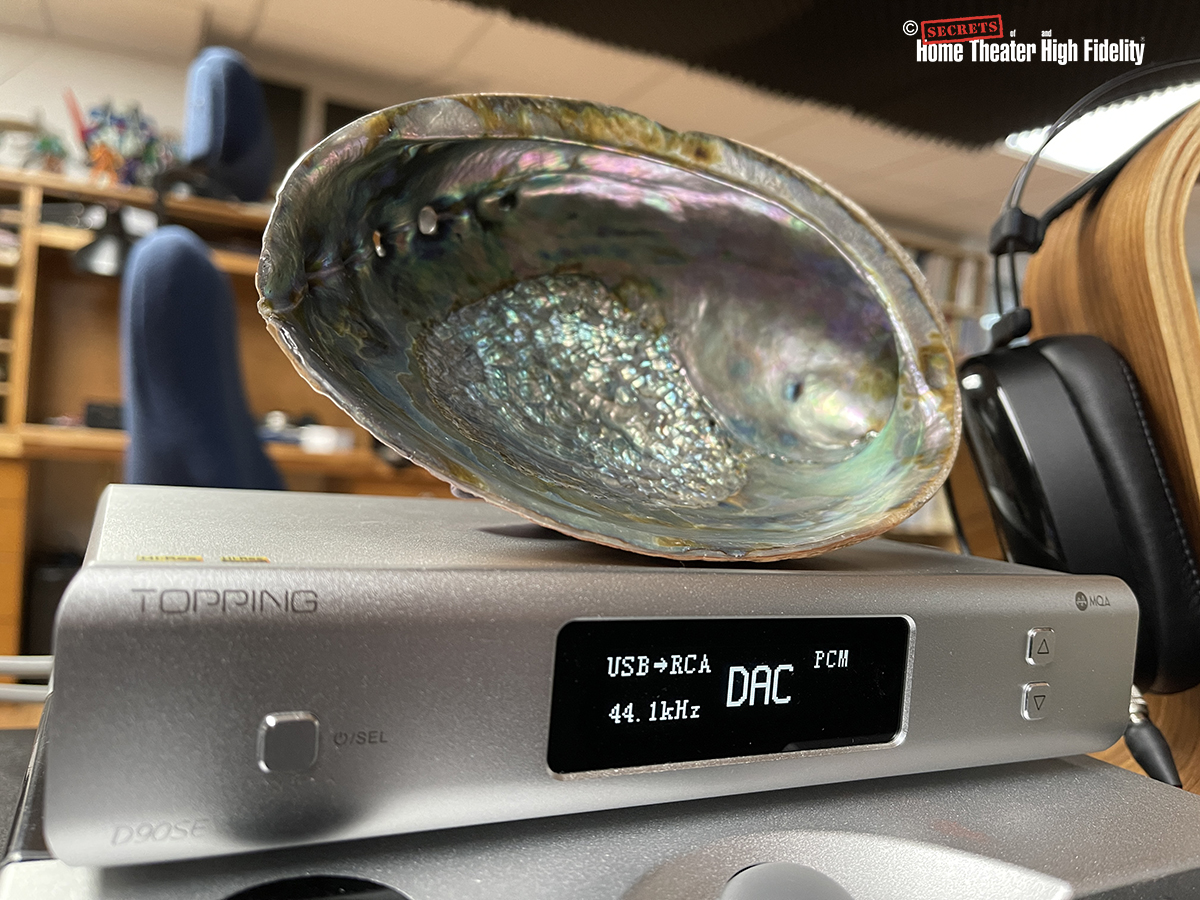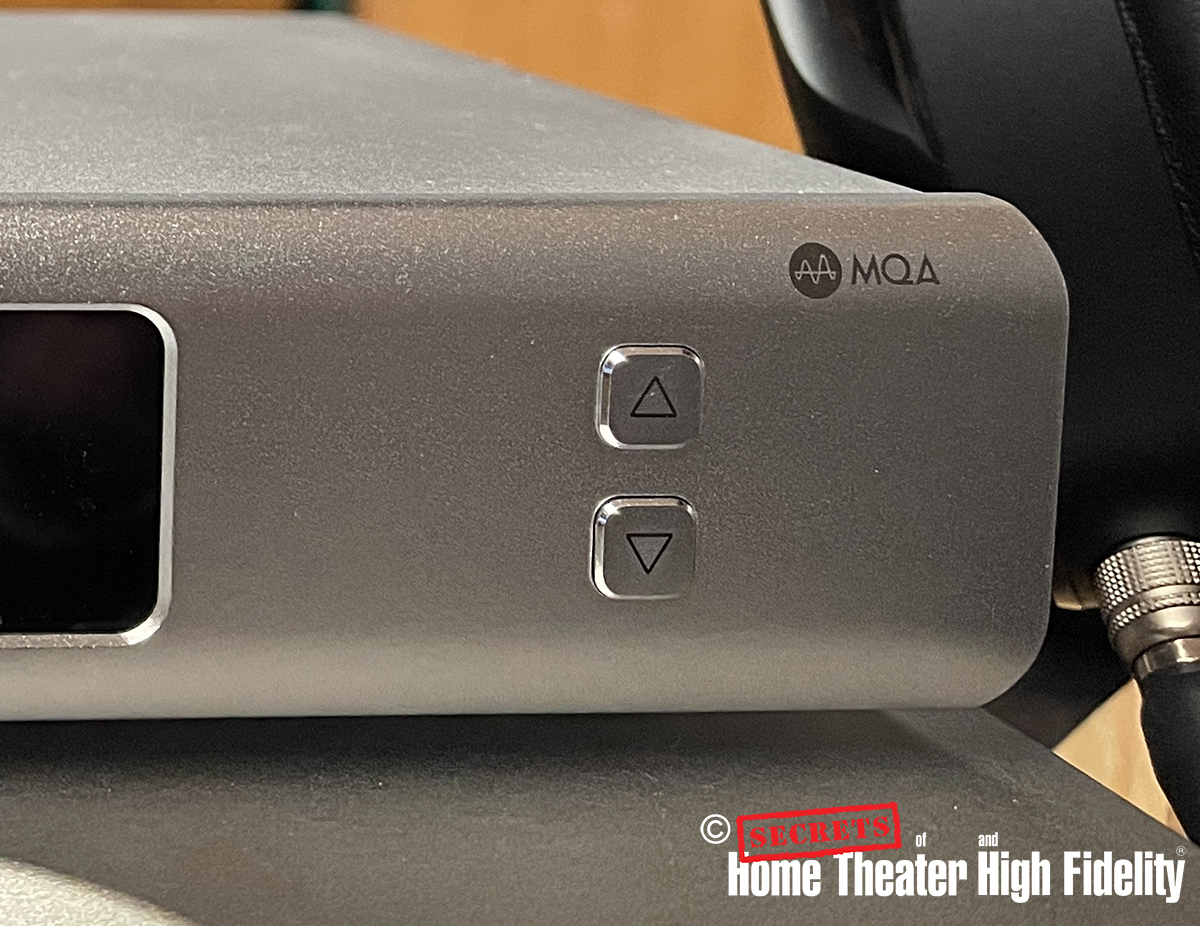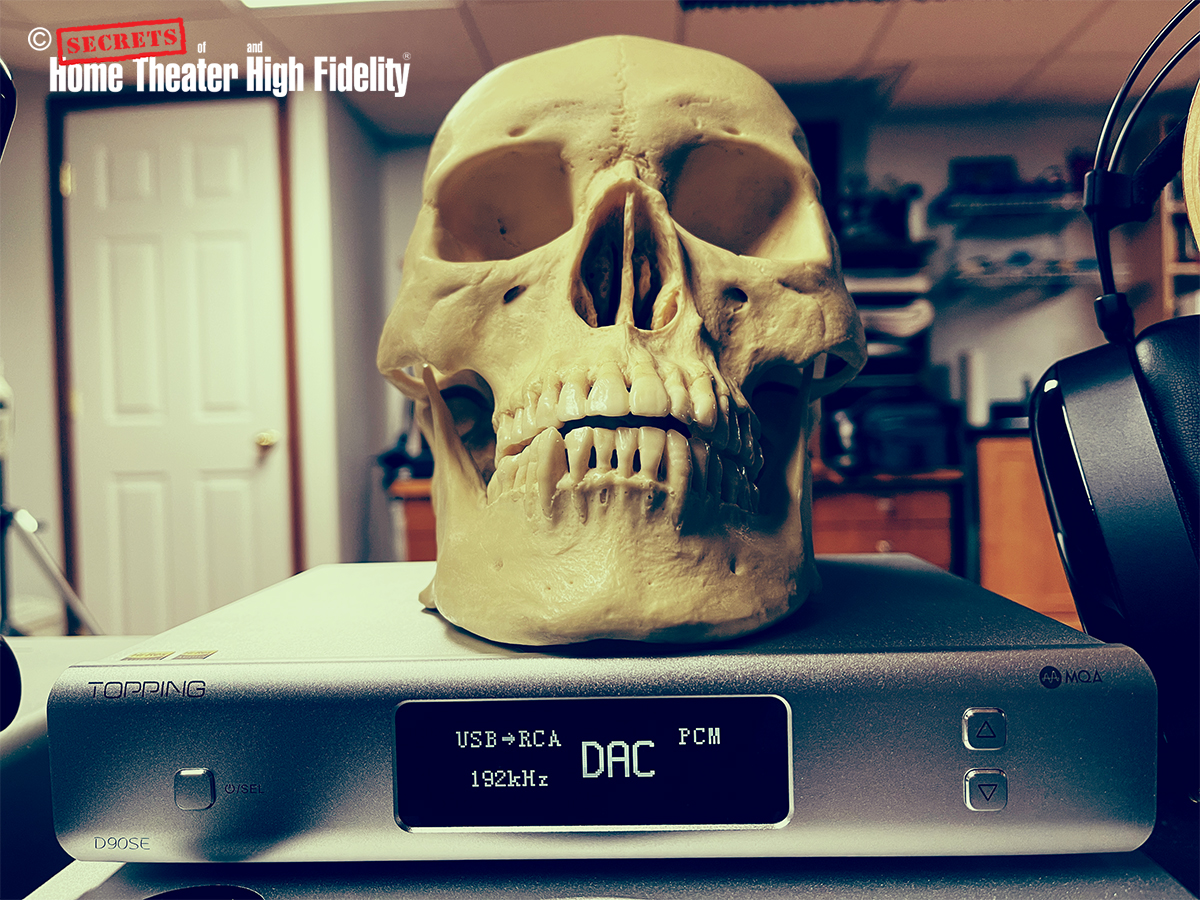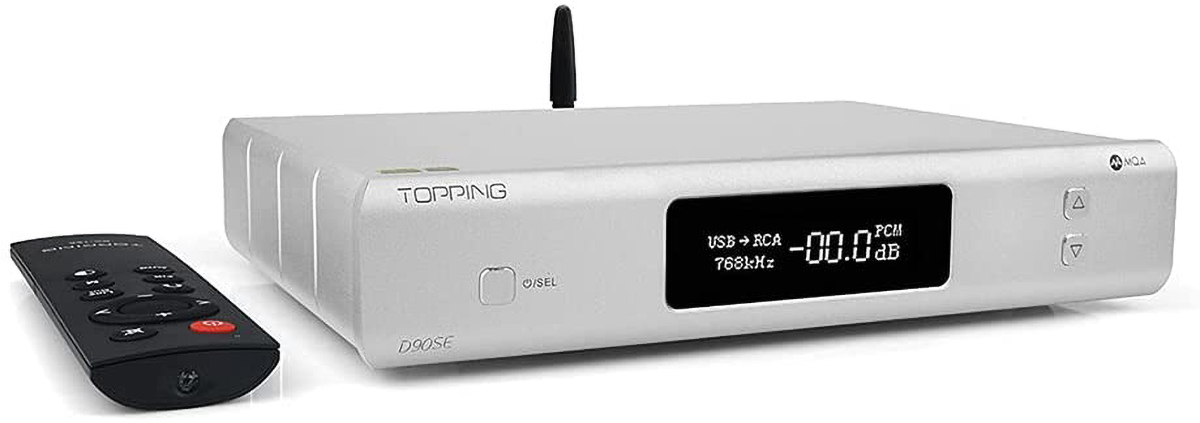
Topping D90SE, ¾ view with remote.
The Topping D90SE DAC continues the company’s tradition of offering objectively high-performance audio products for reasonable prices. But don’t let the product’s deceptively simple exterior fool you. For being a straightforward DAC, the D90SE provides a surprising amount of feature customization to suit your taste.
Topping D90SE DAC
- Simple black or silver box with quality parts and a fully balanced design inside.
- Full MQA functionality across all digital inputs.
- Absolutely clean and transparent sound quality with plenty of detail.
- Bluetooth 5.0 input accepts AAC, aptX HD, and LDAC codecs.
- Some of the best-measured performance of any DAC I have reviewed.
- DAC can decode almost any bitrate and format.
As most readers are undoubtedly aware, Topping is a well-established Chinese manufacturer of compact and high-performance audio components. The fact that their products perform so well and are reasonably priced makes the brand a favorite with both the budget-conscious and the more pragmatic audiophiles out there. We’ve had a chance to review a handful of Topping products in recent years, among them the D10 DAC, the D10s DAC and the DX7PRO DAC/Headphone Amp, and found them to provide exceptional performance and value. In this review, I get a chance to put Topping’s current top-of-the-line DAC, the D90SE, through its paces. Does it give larger, more expensive DACs something to worry about? Read on and let’s find out!
Secrets Sponsor
Design:
Ultra-Low distortion, Fully Balanced DAC
DAC Chipset:
Single ESS Sabre ES9038PRO 8-channel chip.
Manufacturer Freq. Response:
20 Hz – 20 kHz (+/- 0.1 dB)
Signal to Noise Ratio (SNR A-weighted):
127 dB (RCA output), 134 dB (XLR output).
Total Harmonic Distortion (THD):
0.0008% (RCA output), 0.0003% (XLR output).
Output impedance:
100 ohms
Output Level (Volts @ 0 dBFS):
2.1V (RCA), 4.2V (XLR) in 4V mode.
2.6V (RCA), 5.2V (XLR) in 5V mode.
Audio Inputs: Digital S/PDIF coaxial (RCA):
Up to 24-bit 192kHz PCM, DSD64 DoP
Optical digital (TosLink): Up to 24-bit 192kHz PCM, DSD64 DoP
AES digital (XLR): Up to 24-bit 192kHz PCM, DSD64 DoP
Digital USB (USB-B): Up to 32-bit 768 kHz PCM and DSD512 (Native) DSD256 (DoP)
I2S Digital (HDMI): Up to 32-bit 768 kHz PCM and DSD512 (Native) DSD256 (DoP)
Bluetooth: AAC, SBC, aptX, aptX-LL, aptX-HD, LDAC
Audio Outputs:
Unbalanced analog RCA
Balanced analog XLR
Operating System Support:
Windows, OSX, Linux
Weight:
4.4 lbs
Dimensions:
222mm x 160mm x 45mm (W x L x H)
Available Colors:
Black Anodized Aluminum, Silver Aluminum.
Accessories:
1 x USB Cable
1 x AC Power Cord
1 x Remote Control
1 x Bluetooth Antenna
MSRP:
$899.00 USD
Website:
Company:
SECRETS Tags:
topping, dac, sabre, balanced, mqa, high resolution, DAC Review 2022
From the exterior, the Topping D90SE looks very much like many of the other DACs and headphone amps in Topping’s current product line. A simple, compact, sturdy aluminum shell, with beveled corners and no sharp edges to be found. All told about the size of an average hardback novel laid flat on its side. The front panel is sparse with just a small standby power/selection button on the left and two identically sized up/down buttons on the right side. In between those, a simple monochrome LED display resides displaying crucial information such as selected input and output, DAC or Preamp mode, Sampling frequency, volume, and data type.
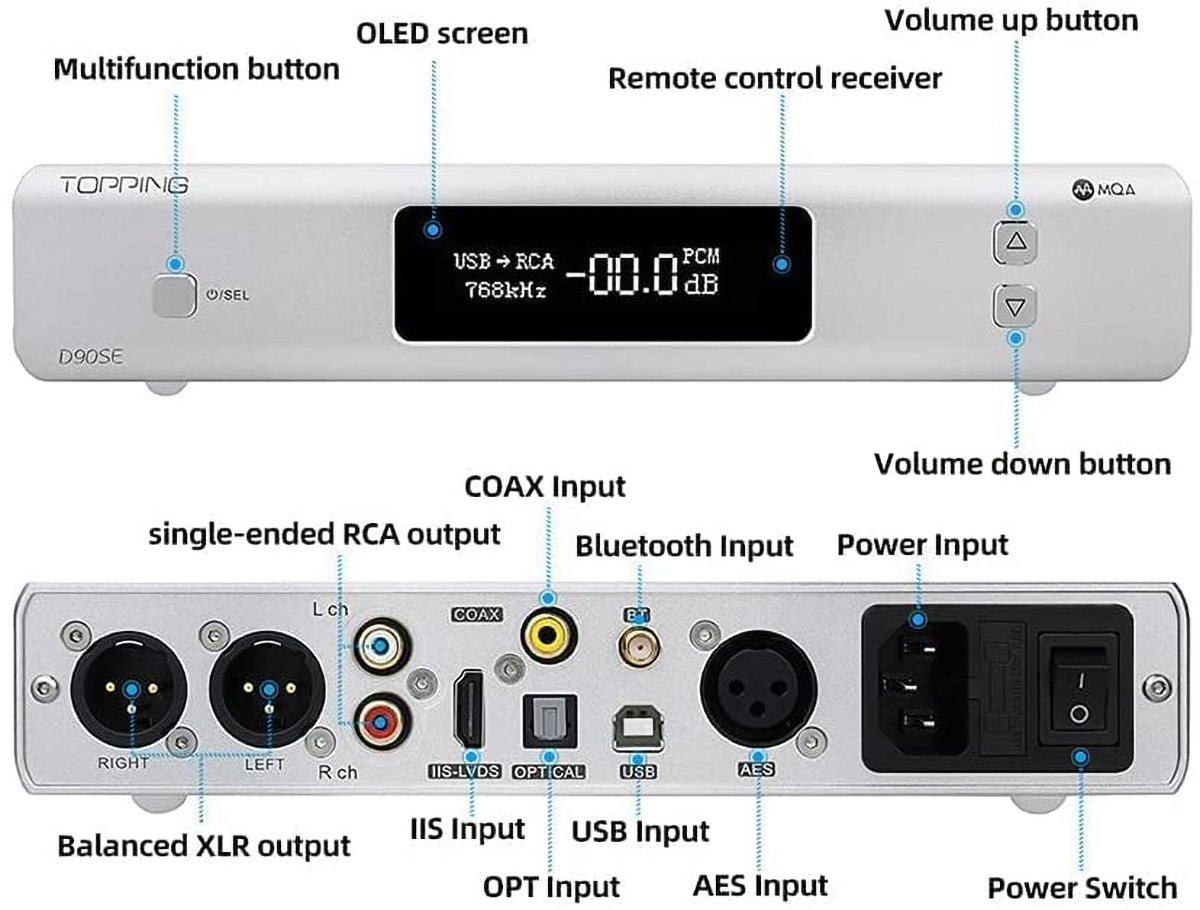 Topping D90SE, front and back panel details
Topping D90SE, front and back panel details
The back panel has pretty much every digital input you could imagine including Optical, Coaxial, Balanced AES, and USB. The USB input is notable as it uses the newest generation XMOS bridge chip and a custom Thesycon ASIO driver for Windows communication. This allows up to 32-bit/768 kHz PCM and DSD512 data rates to flow via your PC. If you don’t need to process DSD natively, the standard Windows 10 WASAPI driver works just as well. There is also a dedicated i2s digital input (via HDMI connector) that allows equally high data rates to move between a suitably equipped digital transport and the D90SE. Do not attempt to hook up a standard HDMI output from an OPPO player or something similar as you will get bupkis as a result. Using a product like PS Audio’s Perfectwave SACD transport with the matching i2s output, for example, would be the way to go to take advantage of this interface.
Secrets Sponsor
The Bluetooth antenna input accepts every flavor of BT codec at the moment, including Sony’s LDAC. Topping uses the Qualcomm CSR8675 Bluetooth 5.0 chipset and states that they bypass the Qualcomm chip’s internal DAC and send the digital BT data stream straight to the main ESS DAC for better sound quality.
The rest of the back panel connections are rounded out by a pair of balanced XLR analog outputs, a pair of single-ended RCA analog outputs, a 3-prong IEC power cord socket, and a master power switch.
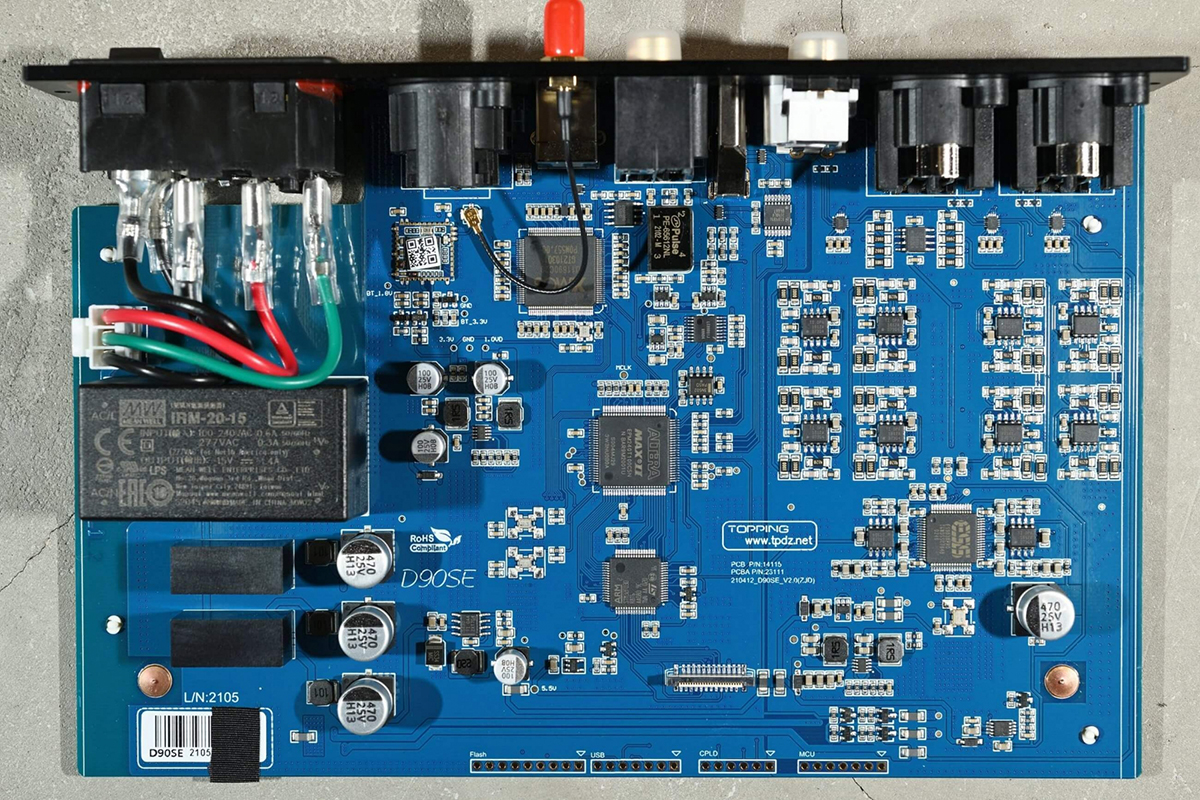 Topping D90SE, the internal board
Topping D90SE, the internal board
Internally, the Topping D90SE uses an ESS ES9038PRO 8-channel DAC with 4 channels each paralleled together, for left and right, to improve SNR performance. The D90SE will fully unfold and decode an MQA music file when presented with one if that is an important consideration for you. If not, Topping makes a D90LE version of this DAC that dispenses with MQA decoding and in its place includes a couple of selectable “sound modes” that simulate either a tube-like or transistor-like sound profile. Beyond that, the two versions of the D90 DAC are essentially identical.
The Topping D90SE will operate as either a conventional DAC or it can be hooked up directly to a power amp and operate as a digital preamp with adjustable digital volume control. It also has two choices of voltage output for pairing with various types of equipment, 2.1 V/4.2V (RCA/XLR) or 2.6V/5.2V (RCA/XLR). These particular features, along with others such as PCM and DSD filters, Phase, BT on/off, etc, can be accessed by turning on the rear panel master switch while simultaneously holding down the front power button to enter the operating menu. Navigating the menu is done using the two front up/down keys and pressing the front power button confirms a selection.
The D90SE also comes with a plastic slimline remote control that can perform all major switching functions, muting, volume control, and cycling of the power.
Accessories include a USB cable, IEC power cord, Bluetooth antenna, remote control, and instruction manual.
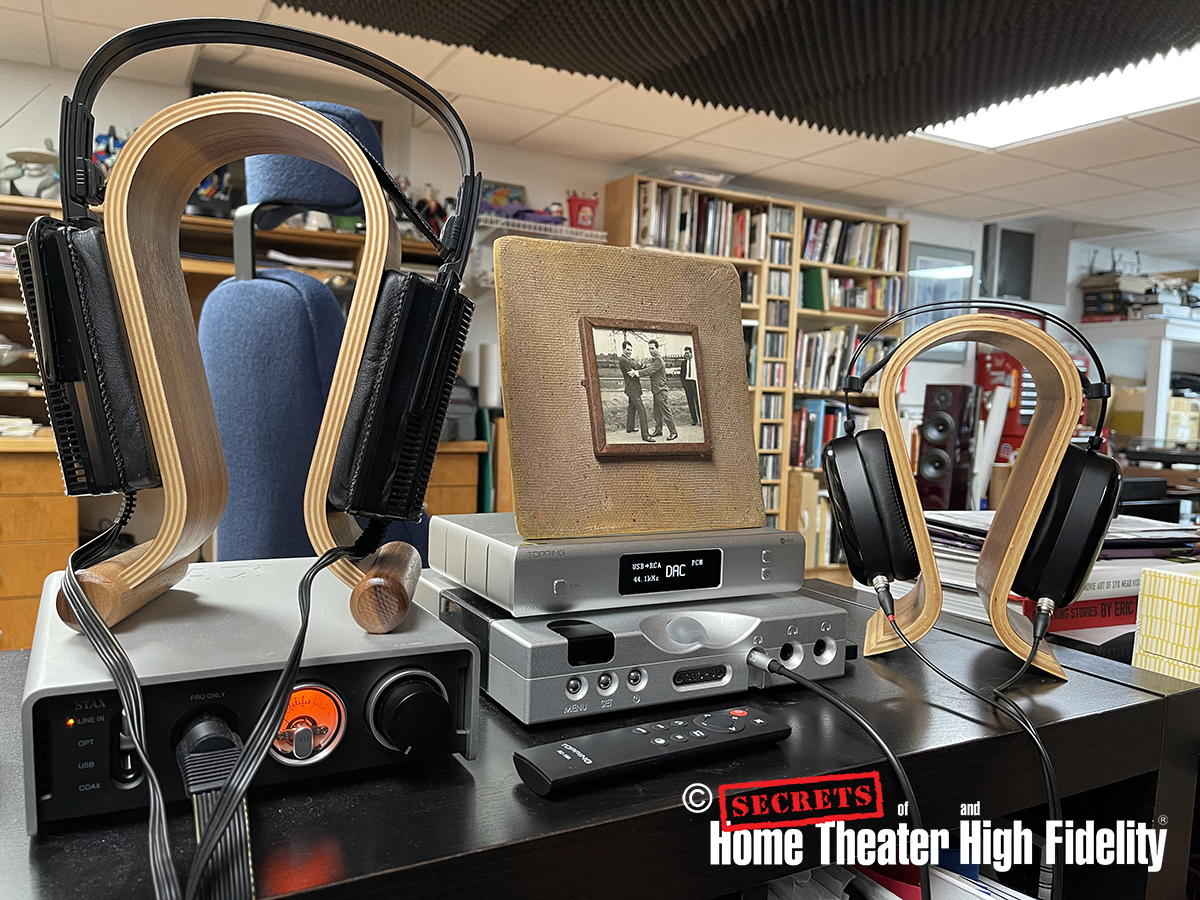 Topping D90SE, headphone listening station
Topping D90SE, headphone listening station
For my review, the Topping D90SE DAC was primarily used via the USB connection with my Surface 3 PRO tablet. The Surface uses ROON to access all my digital music files via an external hard drive and the Qobuz and Tidal streaming services. The DAC output was then sent to a Benchmark HP4 headphone amplifier/preamp and an AHB2 power amplifier. Various speakers and headphones were used to listen to the D90SE, including the Revel F228Be, Bowers & Wilkins 803 D4, Paradigm Founder 120H, Dan Clark Audio Aeon2 Noire, HIFIMAN HE1000v2, and the STAX SR-L700 via its own SRM-D50 amplifier.
We’ve well since gotten to the point now that most quality DACs bring an exceptional level of performance to the table compared to what once was. And more and more that performance can be had at very attainable prices. The Topping D90SE is a prime example of this trend. Sonically it is one of the most neutral-sounding DACs that I have ever come across. Whether listening with speakers or via headphones, the D90SE did not demonstrate any detectable voicing to me. It remained unfailingly clear and transparent regardless of the equipment I paired up with it. Experimenting with the different digital filters made only slight audible differences and I ended up settling on filter 5 (a textbook fast roll-off, linear phase filter) for the bulk of my listening. In many respects, it sounds very much like the Benchmark DAC3 B, and in my book that is meant as a compliment. If you are looking for a DAC that is completely transparent, to give you exactly what is on your digital media or in your music file without embellishment of any kind, the D90SE is right up there with the best of them. If you like a warmer or softer sound from your ones and zeros or are smitten by the tube bug, you may want to look elsewhere. Transparency is the coin of the realm with the D90SE. DSD256 and 384 kHz PCM are the highest resolution music files that I have in my library and the Topping D90SE processed them without issue. No unpleasant pops were encountered when switching between DSD and PCM tracks and no buffering issues with either JRiver Media Center or Roon via the USB connection to the DAC either. The downloadable ASIO Windows 10 drivers seemed robust and trouble-free.
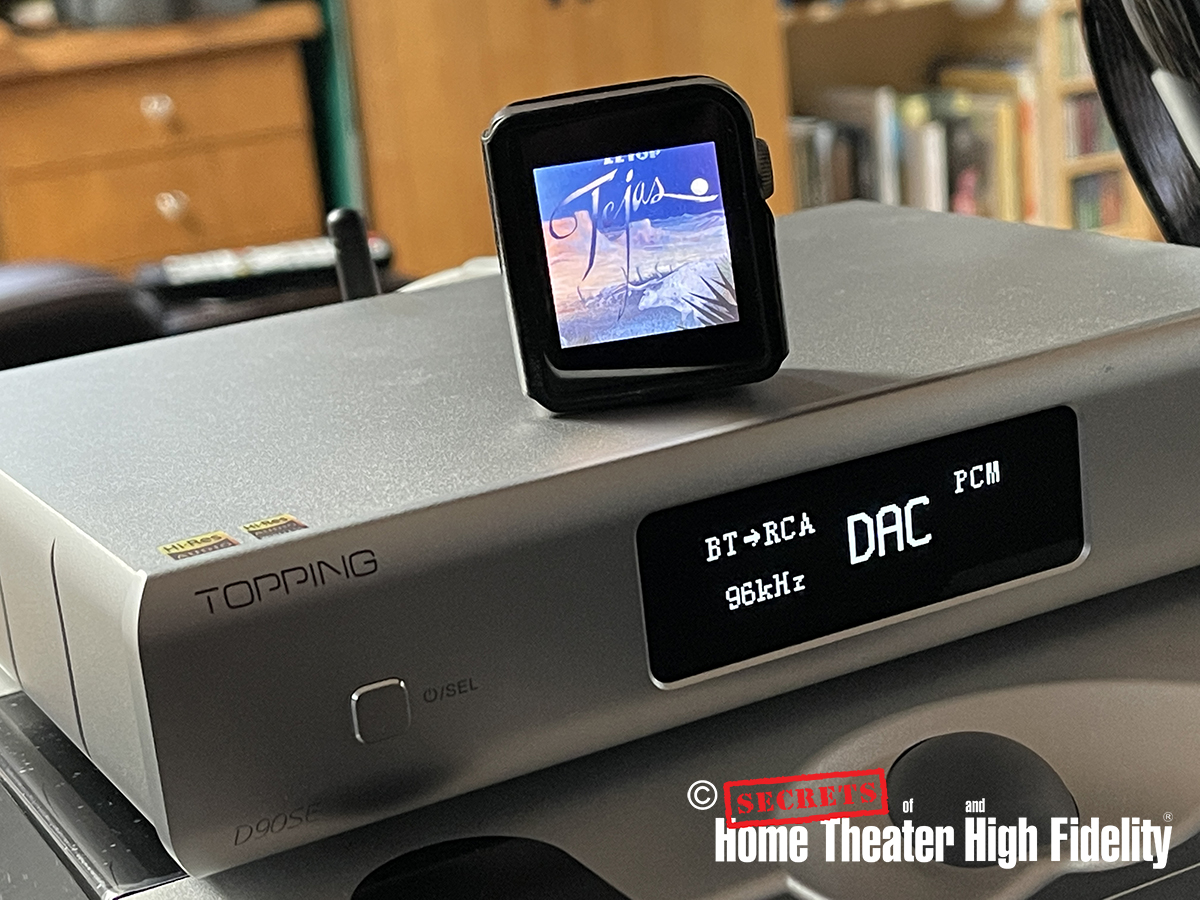 Topping D90SE, with Shanling M0 DAP via LDAC Bluetooth
Topping D90SE, with Shanling M0 DAP via LDAC Bluetooth
I found the Bluetooth functionality of the D90SE to be rock solid. I was able to pair my iPhone 12 with it in seconds and had music streaming to it immediately after using the Onkyo HF player app. The D90SE indicated the AAC stream was being sampled at 48 kHz. Knowing that the Topping D90SE also accepts the LDAC codec, I grabbed my little Shanling M0 player and fired up its Bluetooth radio. With the Shanling set to transmit in LDAC, it found the D90SE and paired with it easily. I was now playing music from this tiny little DAP to the Topping wirelessly at a reported 96 kHz, according to the D90SE display screen. It was some of the cleanest sounding Bluetooth audio that I have ever heard. However, unlike the iPhone which could be up to 20 feet away from the DAC before dropouts in sound started occurring, the little Shanling player had to stay sitting on the D90SE to maintain a solid connection. Not surprising due to its size and lower transmission power. But while sitting there on the DAC, no dropouts in sound occurred.

John Williams and Yo-Yo Ma A Gathering of Friends“Sony Classical, 2022, 24/96 FLAC via Qobuz”
A nice selection of music to listen to via headphones and draw by. Routing the D90SE’s analog out to my STAX headphone amp and earspeakers, I was treated to a stone quiet background from which John Williams, Yo-Yo Ma, and the New York Philharmonic worked. The details in Yo-Yo Ma’s playing throughout “The Concerto for Cello and Orchestra” were frankly astonishing. There was no hint of etch or harshness in the sound of any of the strings, horns, or background percussion. The Topping provided everything my electrostatic headphones and amp needed for them to do their effortless magic with this music. Ma’s and the Philharmonic’s rendition of “the theme from Schindler’s List” simply gave me chills. Sublime stuff this.

Vanessa Wagner, Study of the Invisible“InFiné, 2022, 24/96 FLAC via Qobuz”
I need to thank fellow reviewer Gene Hopstetter for turning me on to this album. A beautiful recording of a piano sensitively played. Again the Topping D90SE did nothing to enhance, detract, or editorialize the glorious spacious piano notes that came forth from this performance. The dynamics from the piano seemed completely natural and unencumbered. “Etude n.6” was just a powerhouse tour de force that sounded huge, whether I used the D90SE with my STAX headphones or in my main system with speakers. Transparent in the extreme.

The Rolling Stones, Live at the El Mocambo 1977“Polydor Records, 2022, 24/96 FLAC via Qobu”
I must have seen about a dozen concerts at the El Mocambo, a seedy little nightclub institution in downtown Toronto. Cramped and sweaty, but with great acoustics are what I remember most about the place. This particular concert occurred in 1977 which would have made me 8 years old and well before my concert-going years ever began. The sound quality of the recording though is outstanding for a live show. A vivid, immediate, and powerful account of a band still very much in its prime. I always thought the Stones were at their best doing old-school blues and “Worried Life Blues” completely delivers the goods here. What good does a super-transparent audiophile DAC do with slithering, raunchy, distorted, music like this? It does every bit as much good as it does with the classical and piano stuff! I could hear every little breath Mick Jagger took before belting out the lyrics of “Little Red Rooster” into that microphone. Keith Richard’s and Ronnie Wood’s double slide guitar action on this track came through with exacting detail. Charlie Watts’s kick drum was punchy and solid and Bill Wyman’s thick, loping bass lines were easily felt as well as heard. Before now, only 4 tracks of this material appeared on the Stones’ album Love You Live. I am so happy all of this material finally has seen the official light of day. The Topping D90SE helps properly experience all of this concert’s awesomeness in the home. I almost felt like I was transported back to the El Mocambo listening to this.
For THD and frequency response tests I used my Lynx 2B professional soundcard teamed with SpectraPLUS measurement software. For square and sine wave analysis along with SNR measurements, I used the Quantasylum QA401 analyzer and its associated software.
When measured with a voltmeter the following values were observed at the outputs when a 1 kHz, 0 dB test tone was applied: 2.10 Volts at the RCA outputs and 4.20 Volts at the XLR outputs. Placing the DAC in 5V mode I observed 2.60 Volts at the RCA outputs and 5.20 Volts at the XLR outputs with the same 1 kHz test tone.
Unless otherwise indicated, all measurements were done at approximately 4 Volts using the XLR outputs.
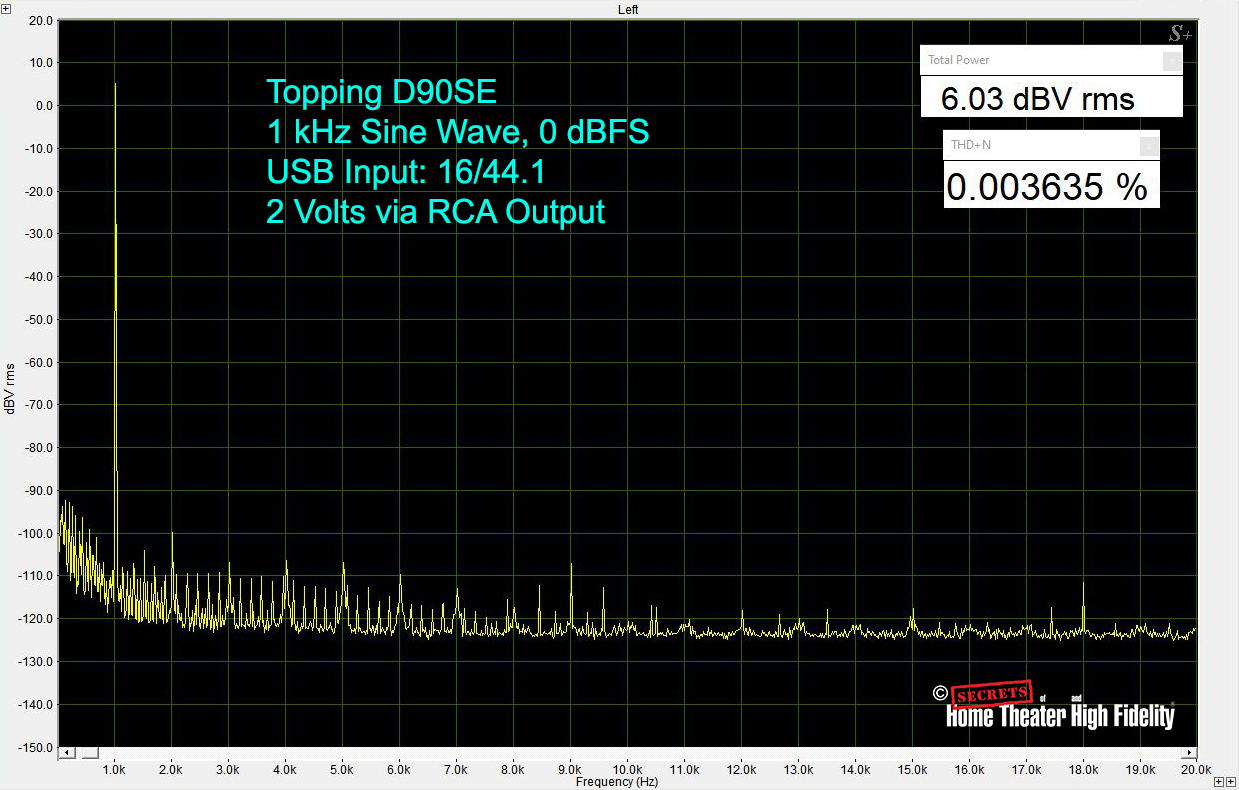 Topping D90SE, 16-bit 44.1 kHz, 1 kHz @ 0dB THD+N, USB in, RCA out
Topping D90SE, 16-bit 44.1 kHz, 1 kHz @ 0dB THD+N, USB in, RCA out
Here we have the first of the 16-bit 44.1 kHz tests. I did them through both the SPDIF Coax and USB inputs and the results proved to be essentially identical. I am showing the USB ones here. A 1 kHz sine wave at 0 dBFS output through analog RCA jacks (2V) produced a THD + N of 0.00364%. A small amount of spurious noise appears at the lower end of the spectrum but its level is inaudible.
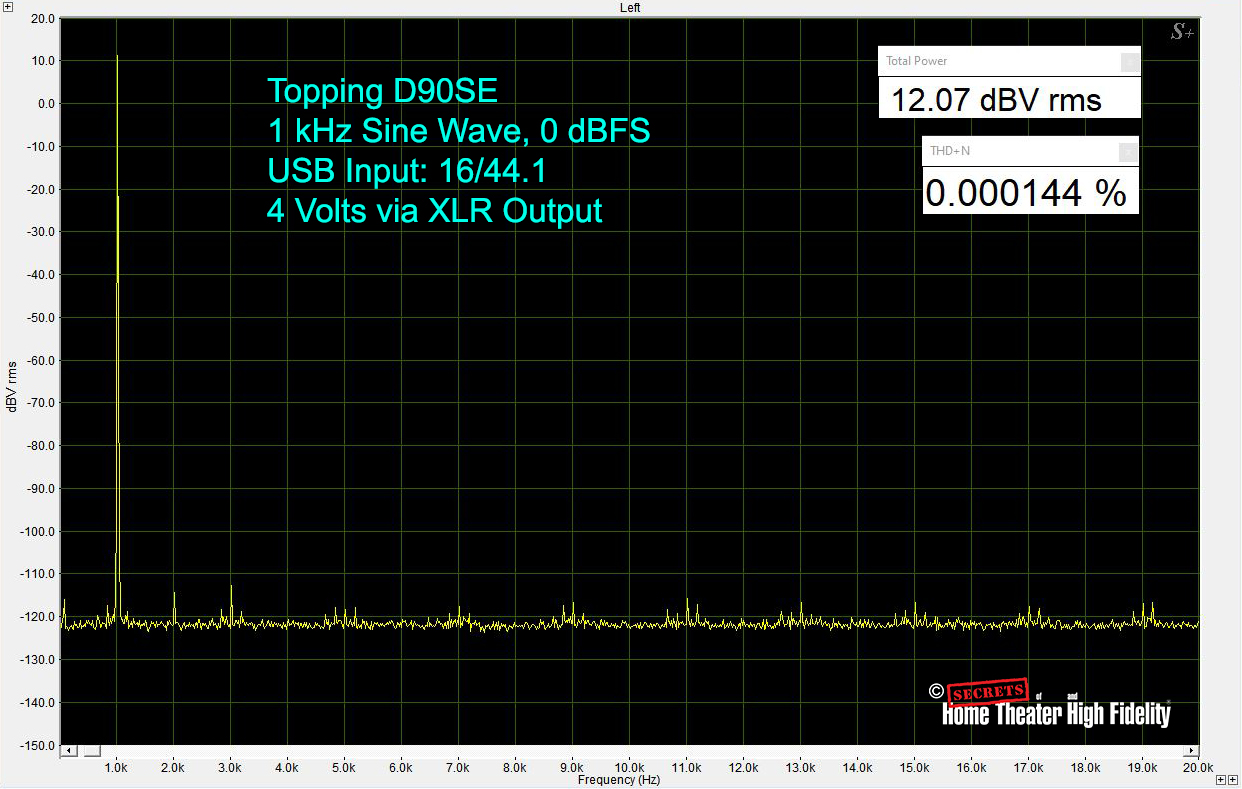 Topping D90SE, 16-bit 44.1 kHz, 1 kHz @ 0dB THD+N, USB in, XLR out
Topping D90SE, 16-bit 44.1 kHz, 1 kHz @ 0dB THD+N, USB in, XLR out
Here we have the exact same test but just output through the XLR jacks (4V). It produced a THD + N of 0.00014%, hitting the limits of our test equipment. Much less noise appears in this spectra due to the balanced connection.
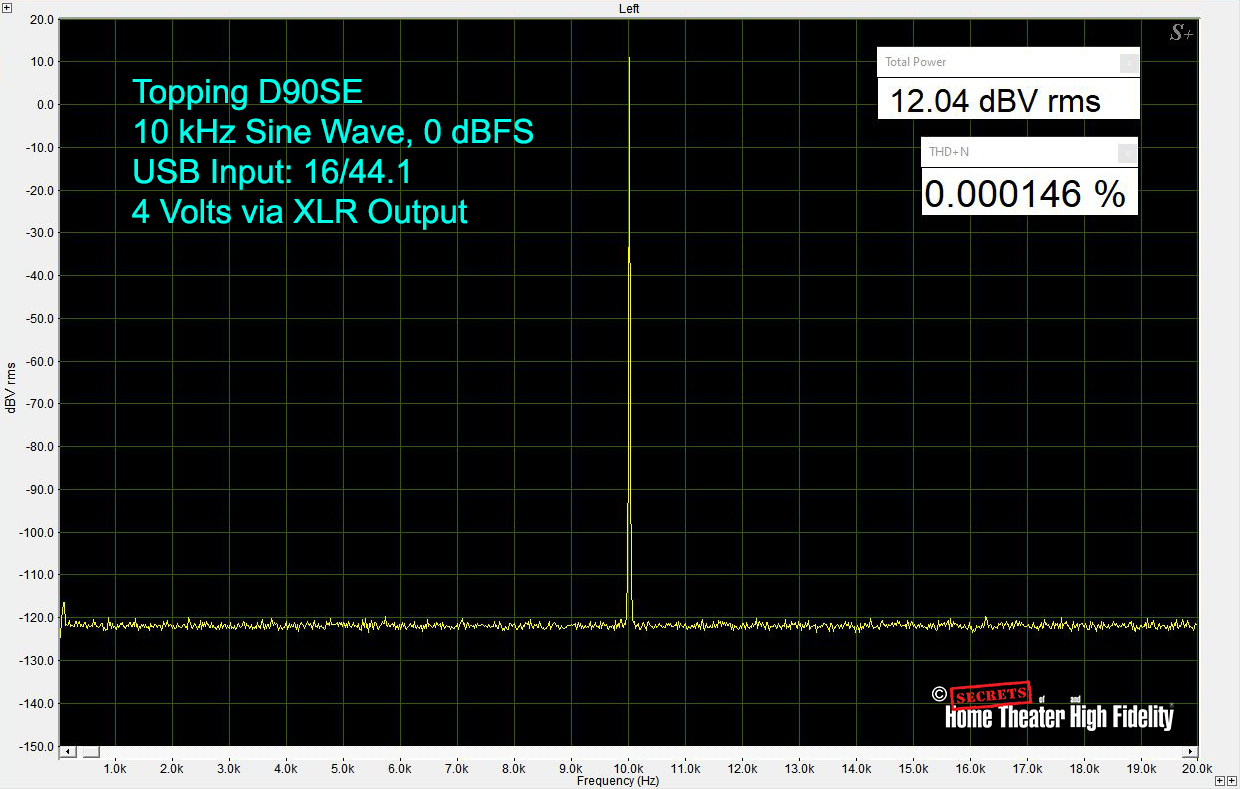 Topping D90SE, 16-bit 44.1 kHz, 10 kHz @ 0dB THD+N, USB in, XLR out
Topping D90SE, 16-bit 44.1 kHz, 10 kHz @ 0dB THD+N, USB in, XLR out
A 16/44 10 kHz sine wave at 0 dB through the XLR outputs produces a THD + N of 0.00015%.
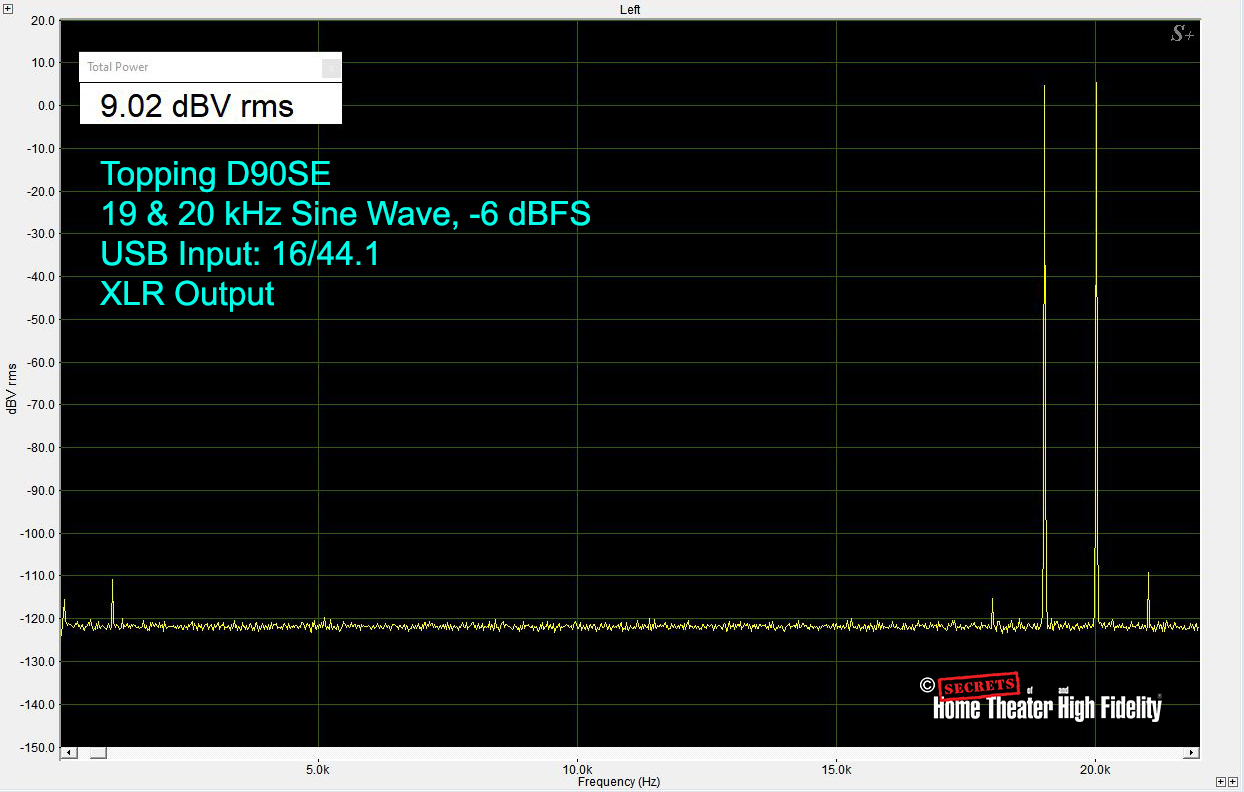 Topping D90SE, 16-bit 44.1 kHz, 19-20 kHz @ -6dB, USB in, XLR out
Topping D90SE, 16-bit 44.1 kHz, 19-20 kHz @ -6dB, USB in, XLR out
The 19 and 20 kHz test tones at -6 dBFS produce clean results with barely any noise spurs or sidebands. Those that appear are at inaudible levels. The Topping D90SE shows excellent performance with all Redbook CD standard tests.
 Intersample over test, reference result
Intersample over test, reference result
The Intersample Over Test was inspired by John Siau at Benchmark Media Systems. It consists of using an 11.025 kHz tone with +3.01 dB signal peaks occurring at a phase angle of 45 degrees from the sample clock. This puts the maximum waveform peaks (higher than 0 dB) between the digital samples. According to Siau, “If audio peaks always fell exactly on a sample, there would not be an intersample overload problem. Obviously, musical peaks rarely fall exactly on a sample and most often fall somewhere between samples. This means that most recordings will have peaks that are over 0 dBFS if the highest sample values are just reaching 0 dBFS.” This condition is more prevalent in 16-bit/44 kHz CD recordings and lower bitrate, lossy formats like MP3, and can produce DSP overload problems in DACs. The above image shows how a textbook DAC should decode the Intersample Over test tone, with no additional noise or spurious tones, showing only the 11 kHz tone. A Benchmark application note goes into much greater detail with figures.
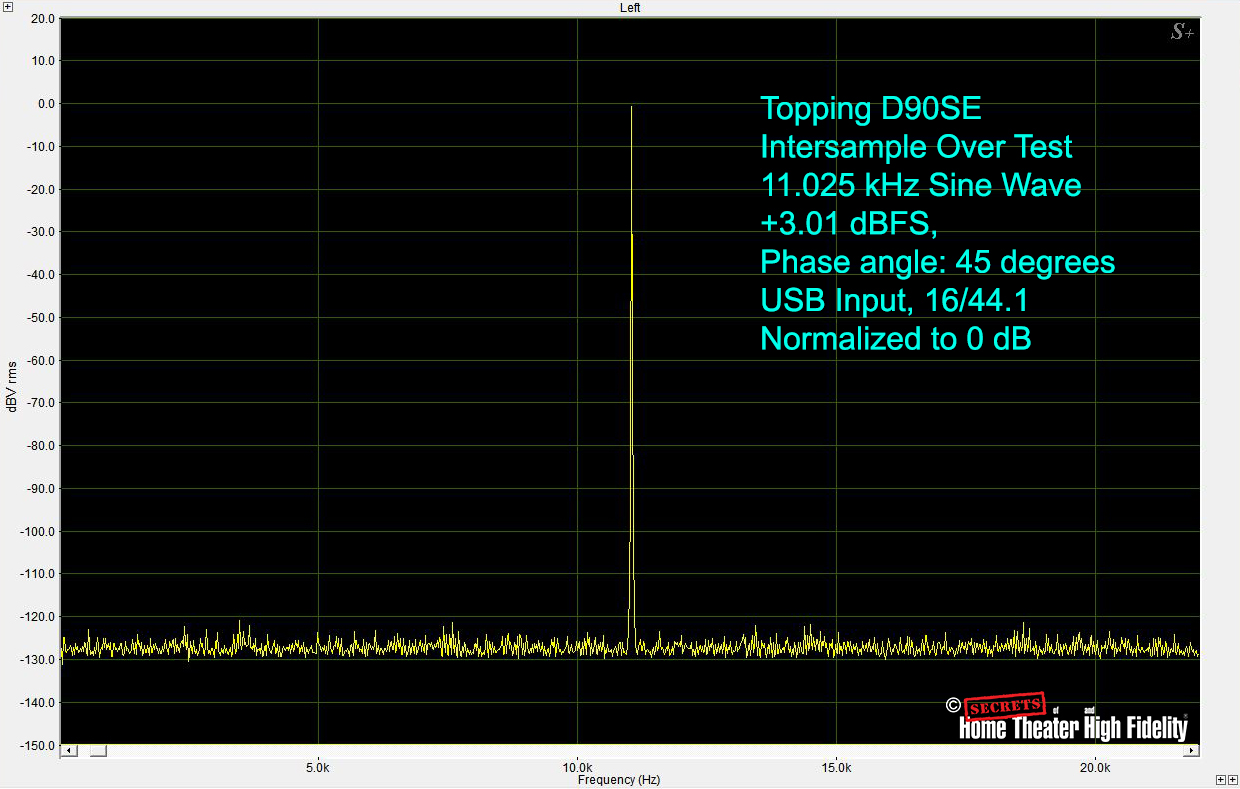 Topping D90SE, Intersample over test, USB in, XLR out
Topping D90SE, Intersample over test, USB in, XLR out
The above image is the Intersample Over Test on the Topping D90SE. The result also shows an absence of noise or spurious tones indicating that the D90SE decodes and processes the test tone correctly.
 Topping D90SE, 24-bit 96 kHz, 1 kHz @ 0dB THD+N, USB in, XLR out
Topping D90SE, 24-bit 96 kHz, 1 kHz @ 0dB THD+N, USB in, XLR out
Moving to the 24-bit/ 96 kHz tests, again both the USB and SPDIF Coax inputs were tested with almost identical results. This is a 1 kHz sine wave at 0 dBFS producing a THD + N of 0.00012%. Second and third-order harmonics are 127 dB and 121dB below the fundamental.
 Topping D90SE, 24-bit 96 kHz, 10 kHz @ 0dB THD+N, USB in, XLR out
Topping D90SE, 24-bit 96 kHz, 10 kHz @ 0dB THD+N, USB in, XLR out
A 24/96 10 kHz sine wave at 0 dB produces a THD + N of 0.0002%, again with second and third-order harmonics both at 120 dB below the fundamental.
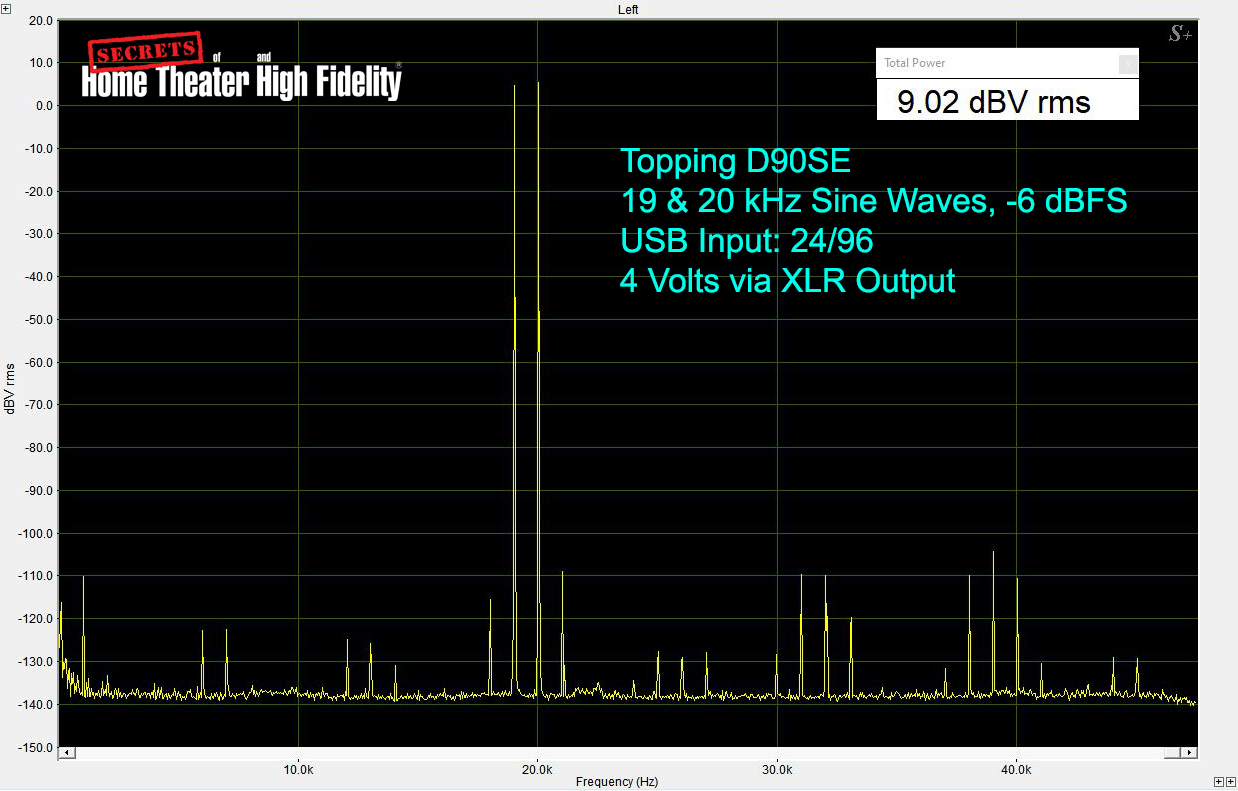 Topping D90SE, 24-bit 96 kHz, 19-20 kHz @ -6dB, USB in, XLR out
Topping D90SE, 24-bit 96 kHz, 19-20 kHz @ -6dB, USB in, XLR out
The 19 and 20 kHz test tones at -6 dBFS produced some small sidebands and spurs, most of which fall below the level of audibility. The second-order harmonics at 38 and 40 kHz are at 119 dB and 120 dB below the fundamental.
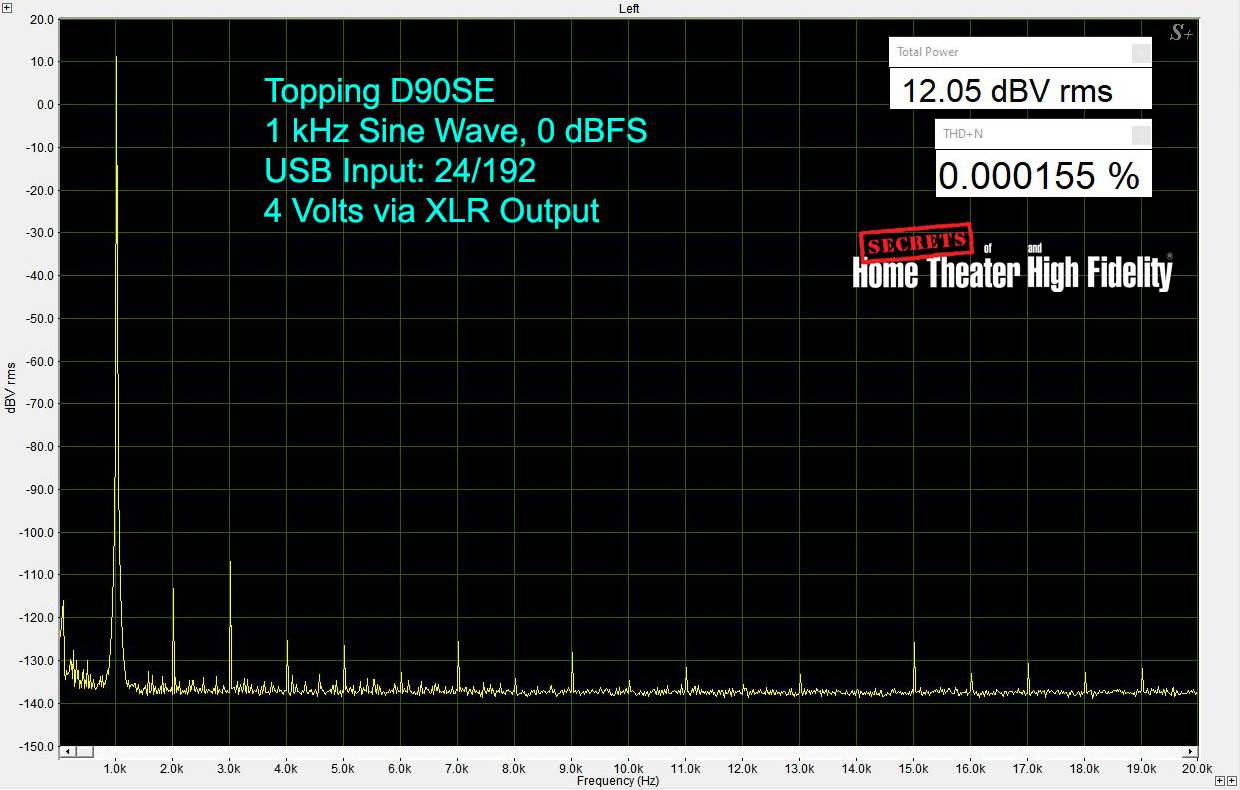 Topping D90SE, 24-bit 192 kHz, 1 kHz @ 0dB THD+N, USB in, XLR out
Topping D90SE, 24-bit 192 kHz, 1 kHz @ 0dB THD+N, USB in, XLR out
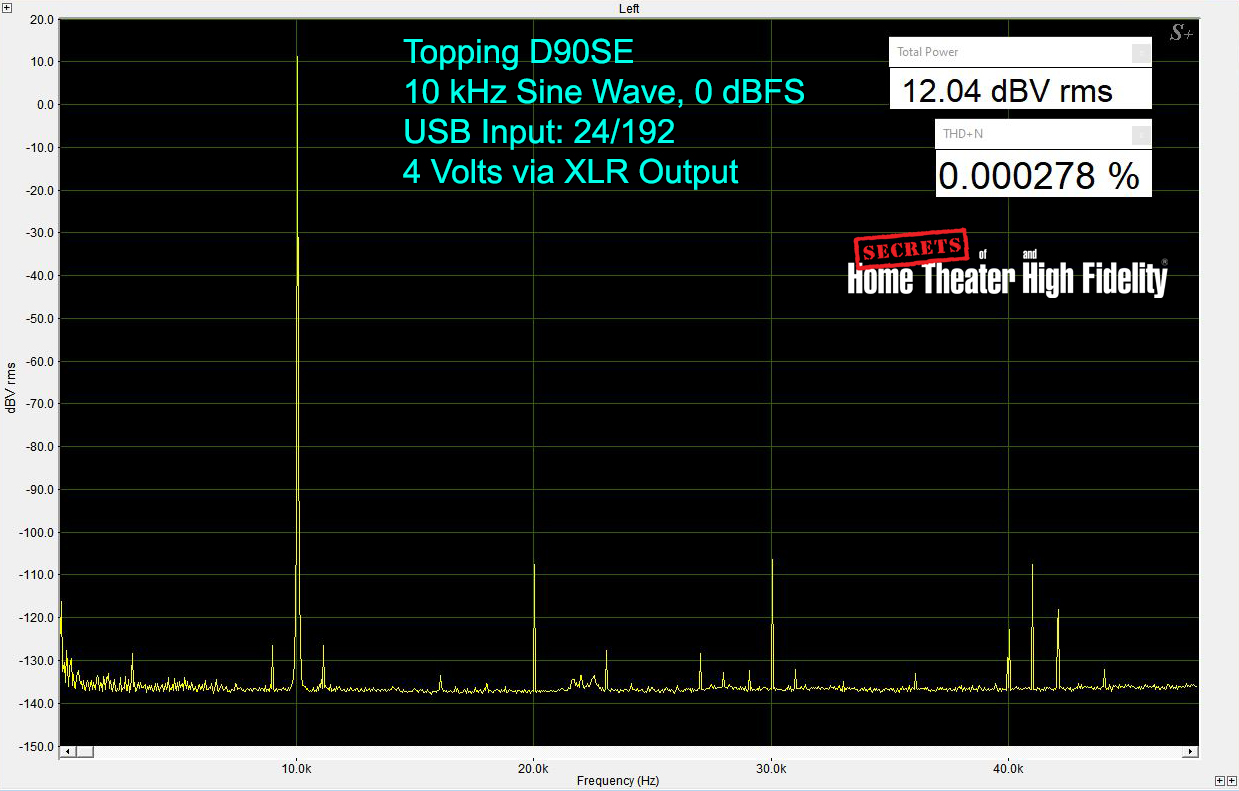 Topping D90SE, 24-bit 192 kHz, 10 kHz @ 0dB THD+N, USB in, XLR out
Topping D90SE, 24-bit 192 kHz, 10 kHz @ 0dB THD+N, USB in, XLR out
 Topping D90SE, 24-bit 192 kHz, 19-20 kHz @ -6dB, USB in, XLR out
Topping D90SE, 24-bit 192 kHz, 19-20 kHz @ -6dB, USB in, XLR out
Above are the same series of tests done at 24-bit/192 kHz resolution, the results are as close as to be essentially identical to the 24-bit/96 resolution tests.
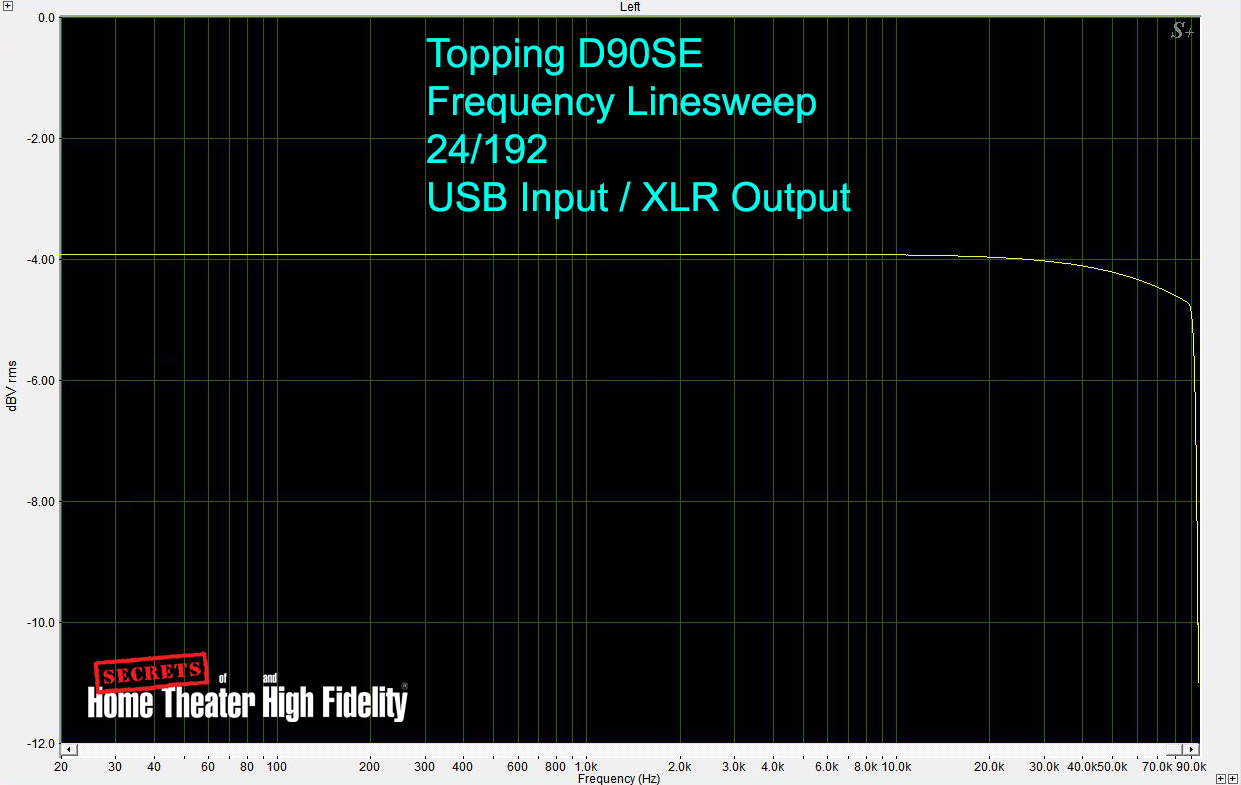 Topping D90SE, 24-bit 192 kHz, linesweep, USB in, XLR out
Topping D90SE, 24-bit 192 kHz, linesweep, USB in, XLR out
The digital frequency response measurement uses a 24/192 line sweep tone from 10 Hz to 96 kHz. The results show a ruler-flat response to 20 kHz. Beyond that, there is a less than 1 dB deviation from 20 kHz to 90 kHz after which there is a sharp roll-off.
The Topping D90SE offers 7 digital reconstruction filters with very different properties. These filter options are built into the ESS DAC chips.
Note: The following digital filter test, first suggested by Jurgen Reis of MBL Germany and used by John Atkinson of Stereophile, is designed to give us a look at the type and performance of the digital filter that a given DAC uses. Unique to John Atkinson’s presentation is applying the Reis white noise only in the right channel. In the left channel is a 19 kHz tone. This tone will produce reconstruction spurs if the digital filter is not sharp enough to attenuate them.
Note that John Atkinson uses a 19.1 kHz tone which produces a symmetrical first reconstruction spur at around half the sampling rate (22.05 kHz). That is so insightful we decided not to reproduce it exactly and just go with 19 kHz which is a frequency typically used in a test for reconstruction spurs. Here I’ve combined the test results of each of the seven filters available on the D90SE with the corresponding square wave that the filter would generate, for comparison.
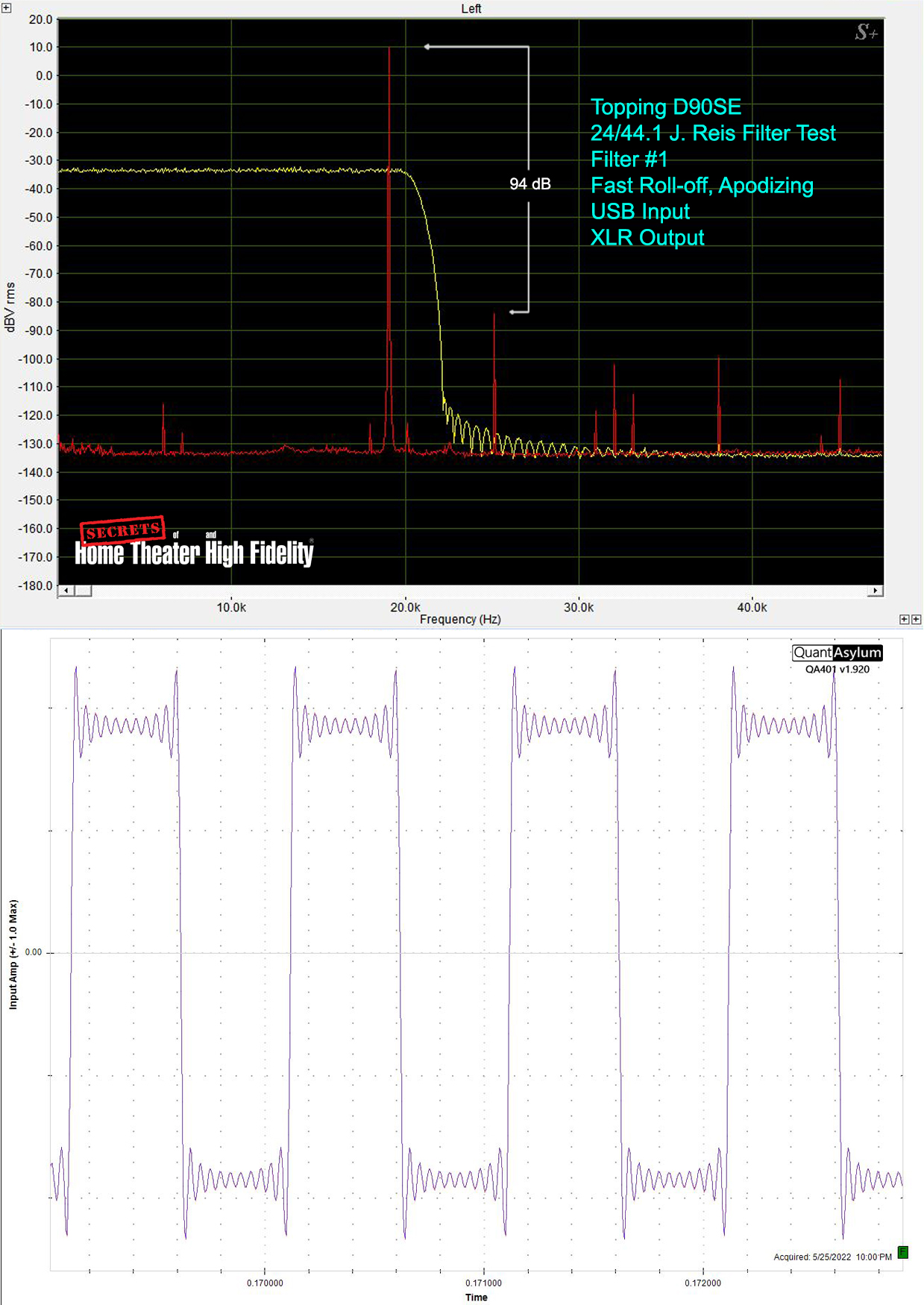 Topping D90SE, Filter# 1: Apodizing Linear Phase filter, fast roll-off
Topping D90SE, Filter# 1: Apodizing Linear Phase filter, fast roll-off
Filter# 1 is an Apodizing Linear Phase filter with a fast roll-off. The plot shows that we get the first reconstruction tone down -94 dB (red trace). The passband (yellow trace) is nice and flat past 20 kHz and then the transition band falls like a brick.
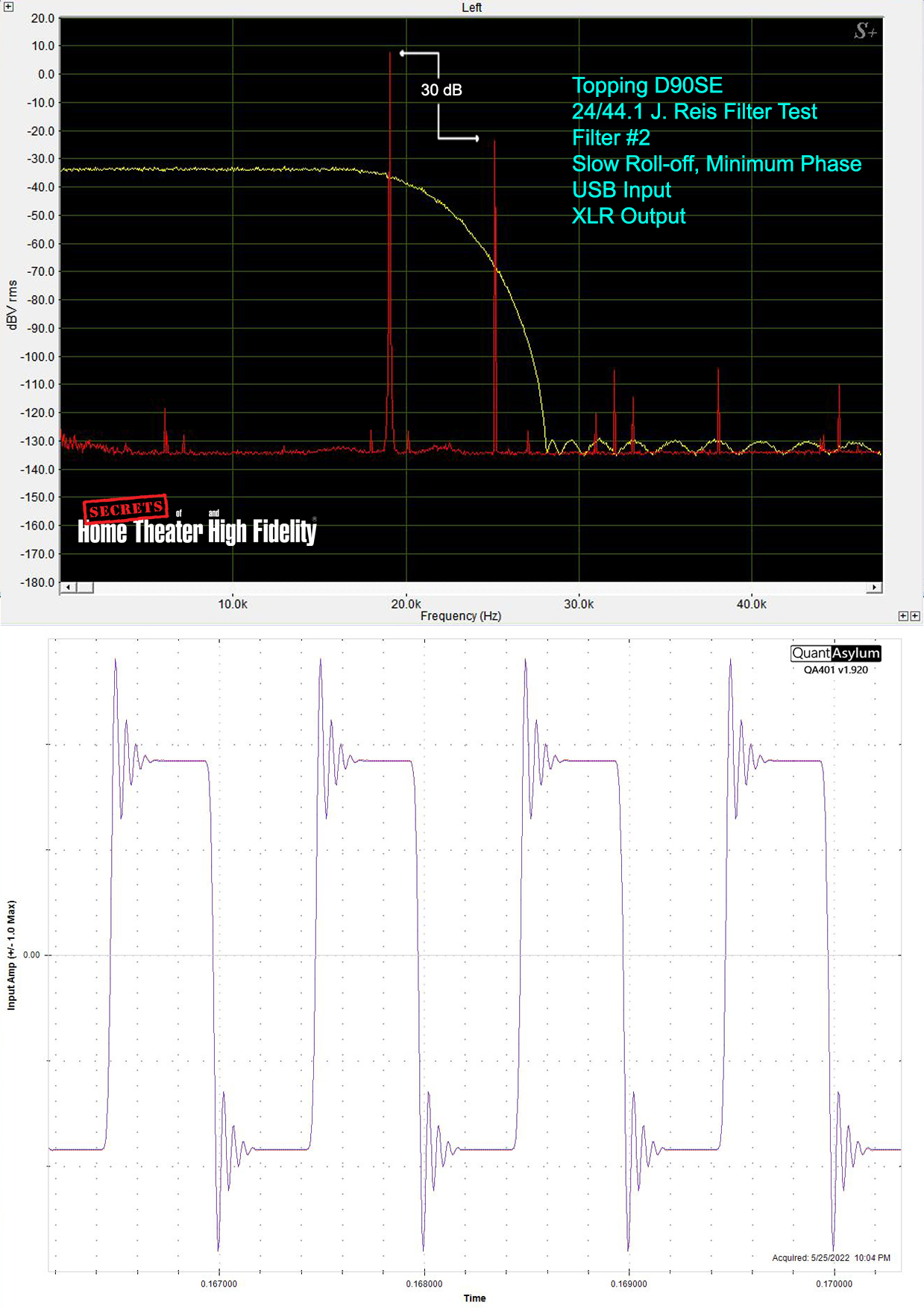 Topping D90SE, Filter# 2: Minimum Phase filter, slow roll-off
Topping D90SE, Filter# 2: Minimum Phase filter, slow roll-off
Filter# 2 is a Minimum Phase filter with a slow roll-off. The first reconstruction tone is down a tiny 30 dB. The filter starts rolling off below 20 kHz. The transition band is really slow, as advertised in the name, and the stopband is deep.
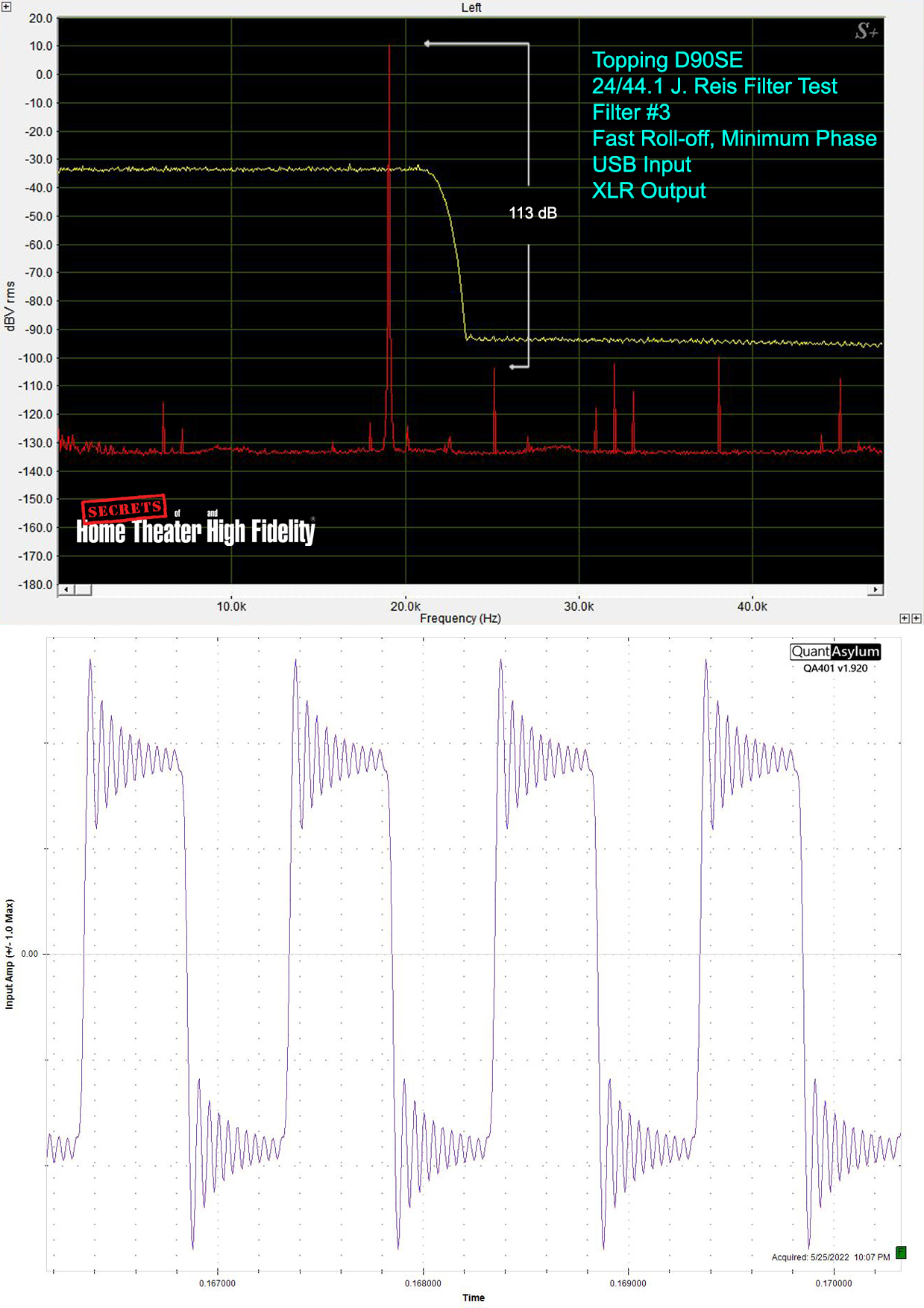 Topping D90SE, Filter# 3: Minimum Phase filter, fast roll-off
Topping D90SE, Filter# 3: Minimum Phase filter, fast roll-off
Filter# 3 is a Minimum Phase filter with a fast roll-off. In this case, the first reconstruction tone is down by an excellent -113 dB. The passband remains flat to just past 20 kHz. The transition band drops quickly but the stopband seems shallow at only 60 dB. The stopband was fluctuating significantly during testing so it most likely is a little better than this.
 Topping D90SE, Filter# 4: Linear Phase filter, slow roll-off
Topping D90SE, Filter# 4: Linear Phase filter, slow roll-off
Filter# 4 is a Linear Phase filter with a slow roll-off. The first reconstruction tone is down -25 dB (red). The filter is rolling off below 20 kHz in the passband. ESS added zeros not found in other slow linear phase filters. The zeros get the transition band curving down and falling into a deep stopband. They give the stopband a bumpy look.
 Topping D90SE, Filter# 5: Linear Phase filter, fast roll-of
Topping D90SE, Filter# 5: Linear Phase filter, fast roll-of
Filter# 5 is a Linear Phase filter with a fast roll-off. Here we get the first reconstruction tone down -120 dB (red trace). The passband is nice and flat past 20 kHz and then the transition band falls like a brick. Our test equipment is limiting seeing how deep the stop-band is (yellow trace). This is the filter I settled on for all my listening.
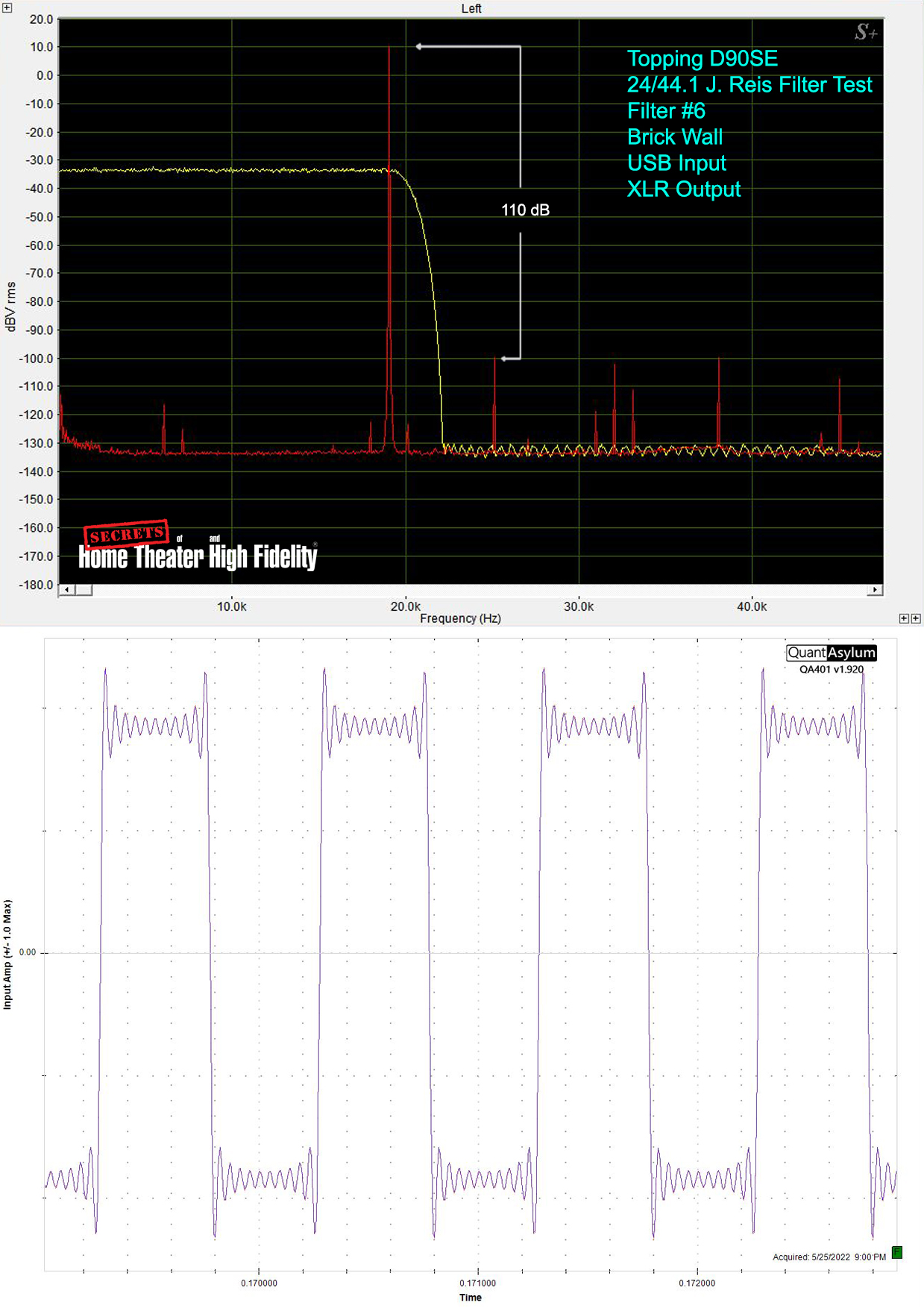 Topping D90SE, Filter# 6: Brick Wall filter, slow roll-off
Topping D90SE, Filter# 6: Brick Wall filter, slow roll-off
Filter# 6 is a Brick Wall type filter with a slow roll-off. This is like the Fast Roll-Off Linear Phase filter we saw earlier but they added more zeros in the stopband, note the bumps, to steepen up the transition band. It is like falling off a brick wall which is why they call this a “Brick Wall” filter. The first reconstruction tone down -110 dB (red trace) with the stopband at about 95 dB.
 Topping D90SE, Filter# 7: Hybrid Minimum Phase filter, fast roll-off
Topping D90SE, Filter# 7: Hybrid Minimum Phase filter, fast roll-off
Filter# 7 is a Hybrid Minimum Phase filter with a fast roll-off. Here we get the first reconstruction tone down -110 dB (red trace). Unfortunately, the passband is rolling off before 20 kHz (and is down by at least 10 dB at that point) but then the transition band falls quickly with a nice deep stopband.
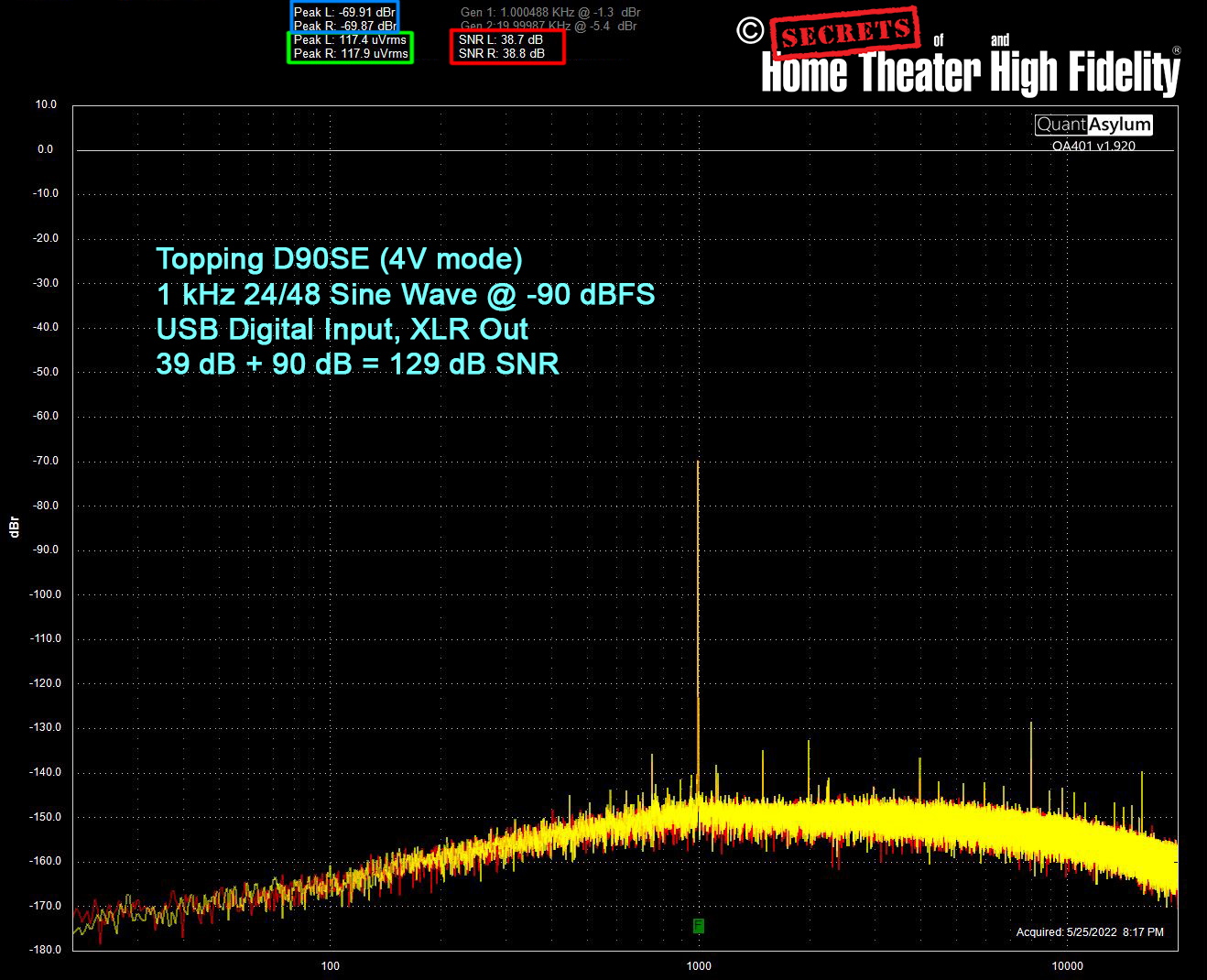 Topping D90SE, SNR test, 4V mode
Topping D90SE, SNR test, 4V mode
SNR measurements were done using the QuantAsylum QA401 Analyzer. In the DAC’s 4V mode using a -90 dB 1 kHz test signal, and measured through the XLR outputs, we determined the digital SNR (A-Weighted) of the Topping D90SE to be 129 dB. Converted to bits that means the D90SE can resolve 21.3-bits. On the top of the spectrum, you see the SNR of the D90SE and then see the signal to noise of the left and right channels relative to the -90 dB tone (red box). We want the ratio of the full-scale signal to the noise, so we add 90 dB. This also provides plenty of headroom to use the digital volume control if you choose. Any DAC with an SNR of 120 dB or less should be used with a good analog volume control (using relay ladders for example) found in a high-quality preamp.
The top of the spectrum also shows the exact signal levels of the incoming -90 dB WAV files. A bug in the spectrum analyzer (what do you want for $450) has an error of +20 dB. Subtract 20 to get the correct value (blue box). The actual size of the waveform is in the green box.
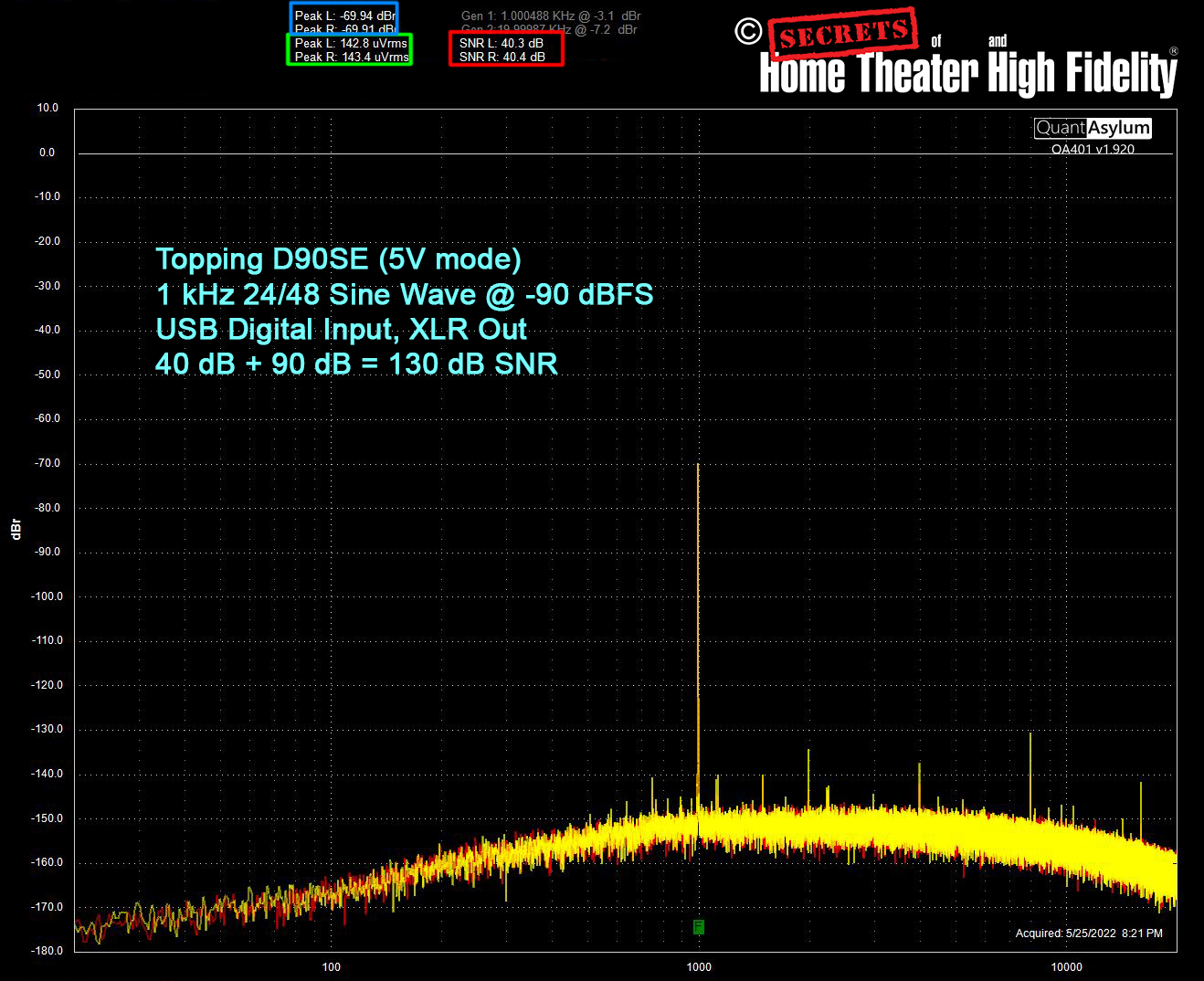 Topping D90SE, SNR test, 5V mode
Topping D90SE, SNR test, 5V mode
In the DAC’s 5V mode using a -90 dB 1 kHz test signal, and measured through the XLR outputs, we determined the digital SNR (A-Weighted) of the Topping D90SE to be 130 dB. That still equates to 21-bits worth of resolution.
 OPPO BDP-105D, Time-domain plot, -90dB
OPPO BDP-105D, Time-domain plot, -90dB
This is a time-domain plot of a -90 dBFS signal applied to the Oppo BDP-105D on the left channel. It is included here as a reference. The self-noise of the QA401 spectrum analyzer in time-domain mode is shown on the right channel. The right channel is grounded. The QA401 can be seen to have a suitably low noise level for something that isn’t an Audio Precision analyzer.
As with the previous figure, if you look at the top of the oscilloscope figure you will see the amplitude in dB off by -20dB, the amplitude in volts, and the SNR relative to -90 dB. If a noise-free sine wave was applied to the right channel we would see the self-noise riding on the wave.
This is the best result we have gotten so far in this test from available equipment, hence it’s used as a reference point. The BDP-105D has a signal-to-noise ratio of 122 dB without weighting which is what is shown. It had 124 dB with A-weighting which we used in the previous figure. As with the last figure, what is displayed is relative to the waveform’s amplitude of -90 dB so what is shown is 32 dB. The signal level is 143 uVRMS.
 Topping D90SE, Time-domain plot, -90dB
Topping D90SE, Time-domain plot, -90dB
Here is the same plot for the Topping D90SE. The amplitude of the signal is a little less at 123.6 uVRMS. You can see how just slightly cleaner this is over the Oppo’s -90 dBFS sine wave, given the better SNR of the D90SE.
 Topping D90SE, Time-domain plot, -100dB
Topping D90SE, Time-domain plot, -100dB
We’ve now dropped the level of the sine wave to -100 dBFS or 0.31 the size at -90 dBFS. The sine wave has an amplitude of 39.1 uVRMS. The signal to noise drops by 10 dB to 20.2 dB relative to the -100dB tone. This confirms the noise is up by a factor of 3 relative to the tone.
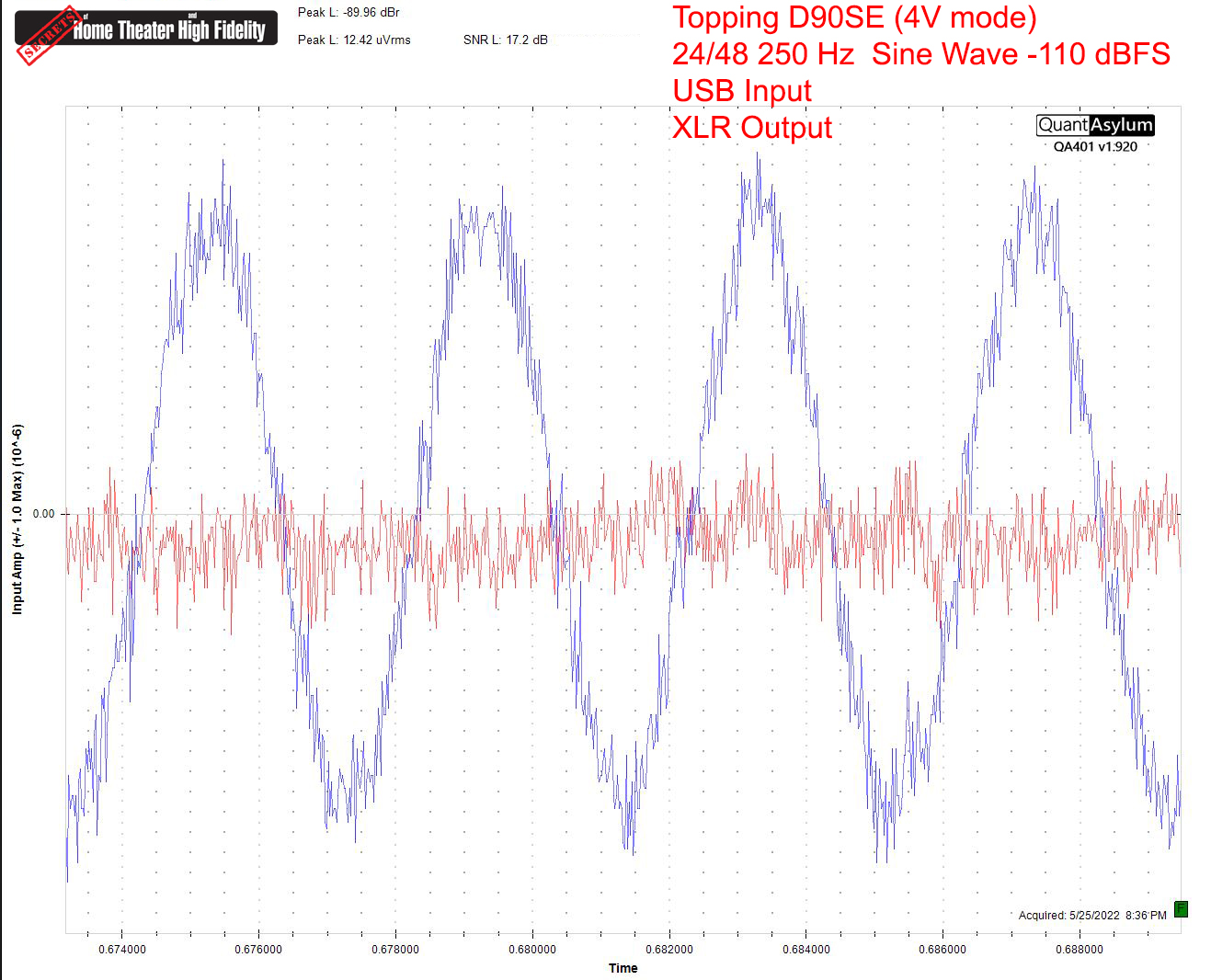 Topping D90SE, Time-domain plot, -110dB
Topping D90SE, Time-domain plot, -110dB
We take the digital input down another 10 dB to -110 dBFS which drops the level by another 0.31. Again the screen was magnified by 3 to make the wave look the same size as the two that preceded it. The noise of the Topping D90SE is making the sine wave harder to see but is still visible above its noise floor. The amplitude of the sine wave is at 12.4 uVRMS. The signal-to-noise ratio is now 17 dB relative to the -110 dBFS signal. With an SNR of only 17 dB, the waveform is not surprisingly noisy but keep in mind the signal is microscopic at this level. Full scale is 4VRMS. This signal is 0.0000034 of full scale.
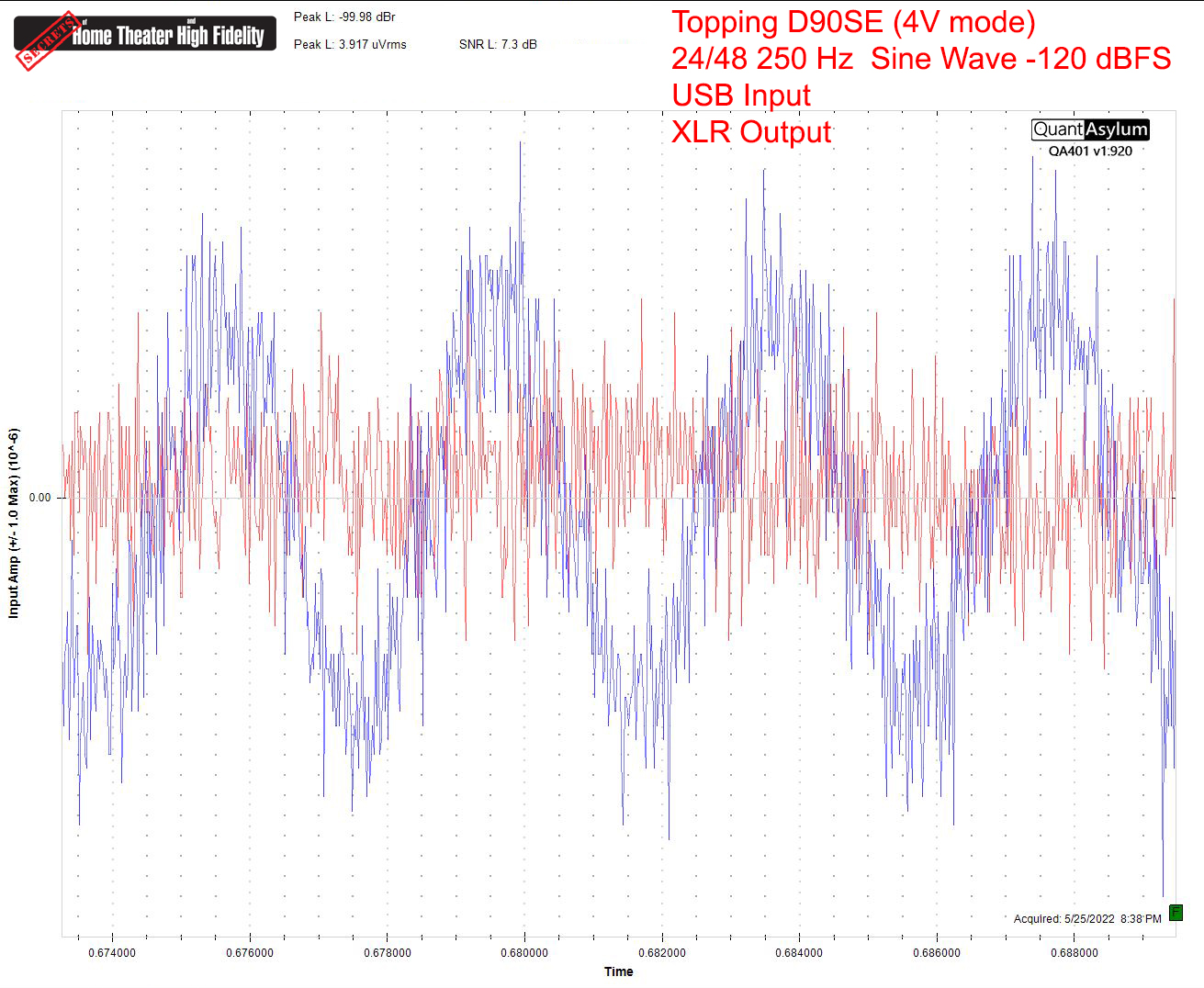 Topping D90SE, Time-domain plot, -120dB
Topping D90SE, Time-domain plot, -120dB
We take the digital input down by another 10 dB to -120 dBFS. This is another reduction of 0.31 and the oscilloscope gain has been increased by 3. At -120 dB it is equivalent to 0.00001 of full scale. A million to one. The amplitude of the full scale 0 dBFS tone out of the D90SE is 4VRMS so the size of the output at -120 dB down is 4 uVRMS. The SNR is now 7.3 dB.
The resulting analysis of these extremely low-level sine waves shows us that the Topping D90SE is probably the highest resolution DAC we have tested, surpassing the very fine results we have previously obtained from the OPPO BDP-105D and other separate DACs. The D90SE’s ability to maintain the semblance of a signal at such crazy low levels is truly amazing.
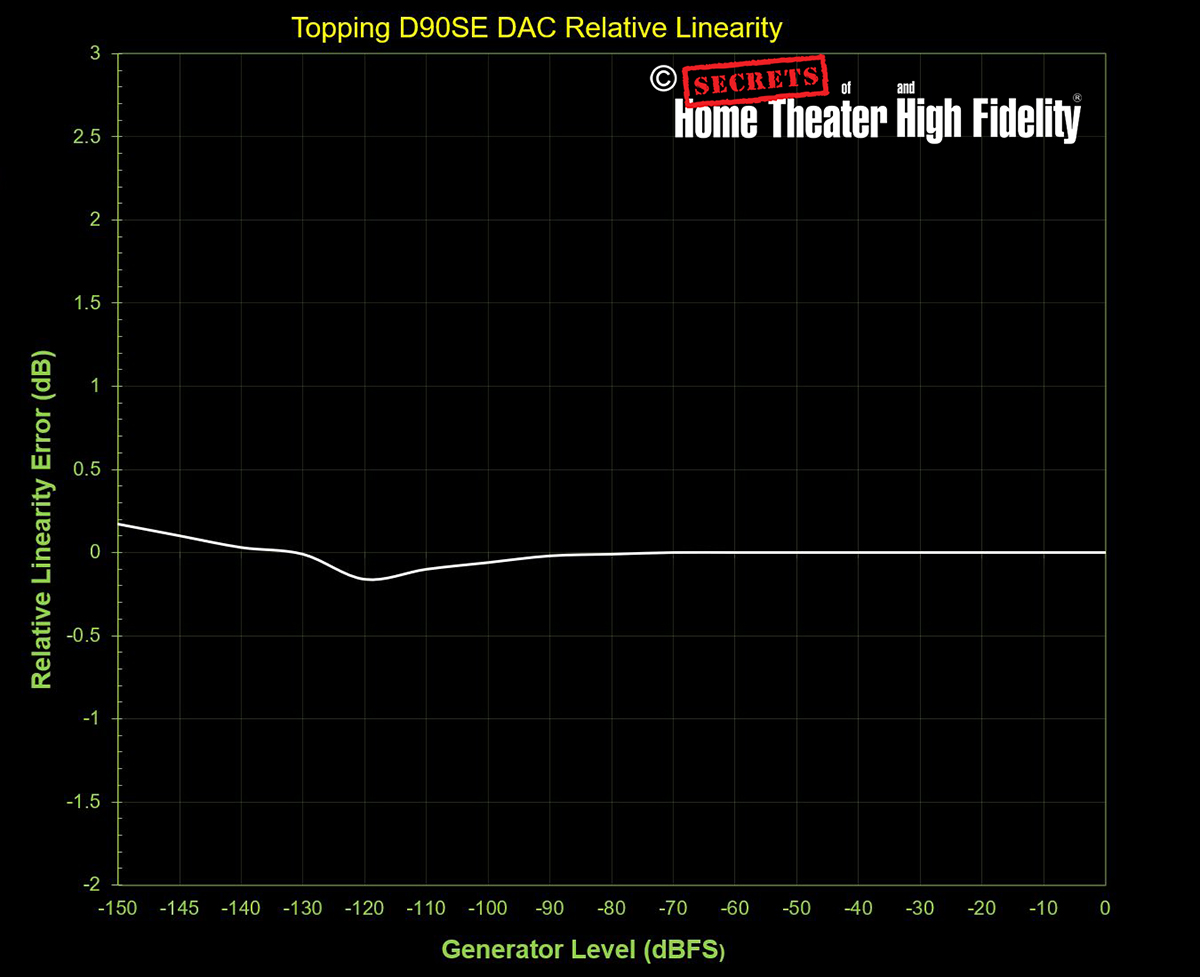 Topping D90SE, Relative DAC Linearity plot
Topping D90SE, Relative DAC Linearity plot
The above graph shows the relative line linearity performance of the Topping D90SE. The ES9038PRO DAC architecture shows minimal amounts of deviation beginning at -90 dB in level. The deviations remain very modest down to -150 dB. Just about the best we have seen.
The final spectrum is the Julian Dunn J-Test for jitter at a sampling rate of 44.1k samples/sec. The test is close to an 11 kHz tone at –3 dBFS down and is a small, low-frequency square wave that creates activity in the PCM data which makes it harder for the clock recovery circuit to produce a clock without some phase noise. I used a 16-bit test generated by REW introducing the square wave at an amplitude of the smallest level possible for 16-bit data which is called the least significant bit. An excellent explanation of the J-Test and the spurs the test produces can be found here. John Atkinson identifies the spur’s amplitude and frequency of the J-Test in absence of jitter. John then comes up with an innovative line to be placed on a spectrum of the analog output of a DAC box which is reproducing the J-Test. Any spur below the line is inherent in the test and not from the DAC box. As can be seen, the jitter of the Topping D90SE is below the limits of the test. The small residual spurs between the lines are small enough that we cannot tell if it is Jitter from the D90SE or the ADC we use to translate the signal back to digital to produce the spectrum.
The Topping D90SE is an uncompromising state-of-the-art DAC for the everyman audiophile.
- State of the art measured performance.
- Completely neutral and transparent sound quality.
- Does everything a good external DAC should, and then some.
- Nothing that I can think of.
I’m finding it very difficult to find fault with the Topping D90SE DAC. It is well made, has superb measured performance, sounds as transparent and devoid of coloration as any other DAC that I have come across, and it won’t cost you an arm and a leg. It is also compact in size and will handle any file format or sampling rate it is likely to encounter. DSD and MQA are completely covered and the no-muss-no-fuss Bluetooth connectivity with every modern BT codec is an incredibly useful and good sounding feature to have. The 5V feature that helps in either driving less sensitive equipment or in opening up a little extra SNR on the DAC end is just icing on the cake.
If I had to nitpick, there is just a little more lower frequency noise in the 2V measurements through the RCA outputs than I would have liked but it happens at such a low level that you’ll never hear it anyway. Want a second opinion? Ask your pet bat or dolphin. And the exterior styling of the Topping D90SE is understated and very conservative. I have a Chord Hugo TT2 in for review that provides way more visual eye candy than the Topping does. That’s it. That’s all the “kind-of-negative” stuff I can come up with.
If you want a DAC that tints your music with rose-colored glasses, the Topping D90SE is not for you. As I wrapped up this review Topping released a firmware update that adds the 2 different sound mode options of the D90LE to this DAC. Switching between the new listening modes over headphones I can hear the subtlest of differences. In the end, it’s another feature to play with and it may satisfy all but the most die-hard analog savants out there.
The Topping D90SE is a DAC for listeners who want nothing to get in between them and their music. It reveals all without adding anything that shouldn’t be there. It is very much the ultimate textbook DAC that almost anyone can afford. Highly Recommended.
The author would like to thank David A. Rich for his assistance with this review.




